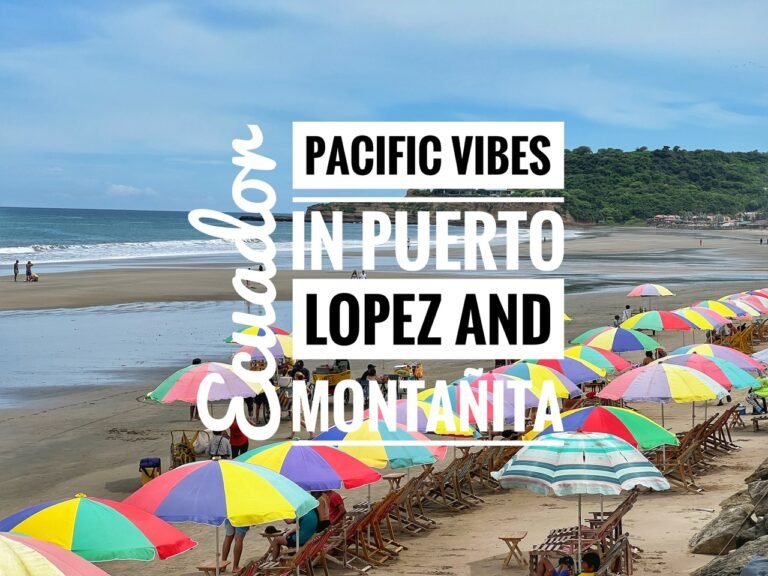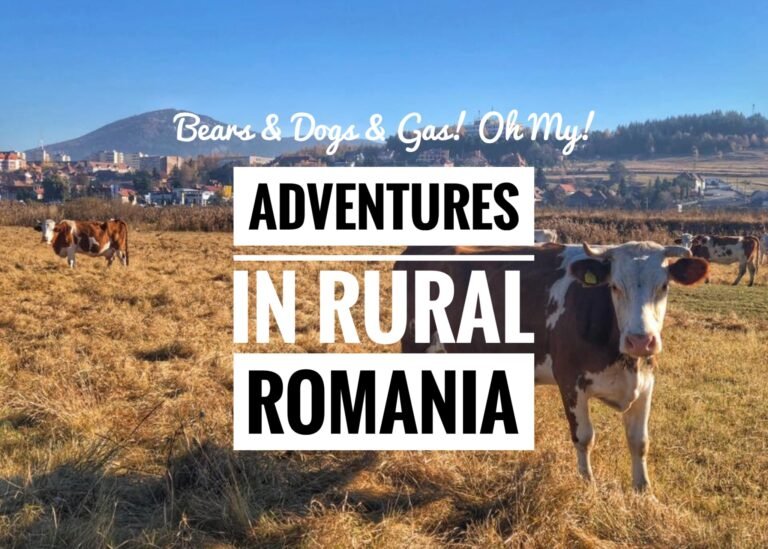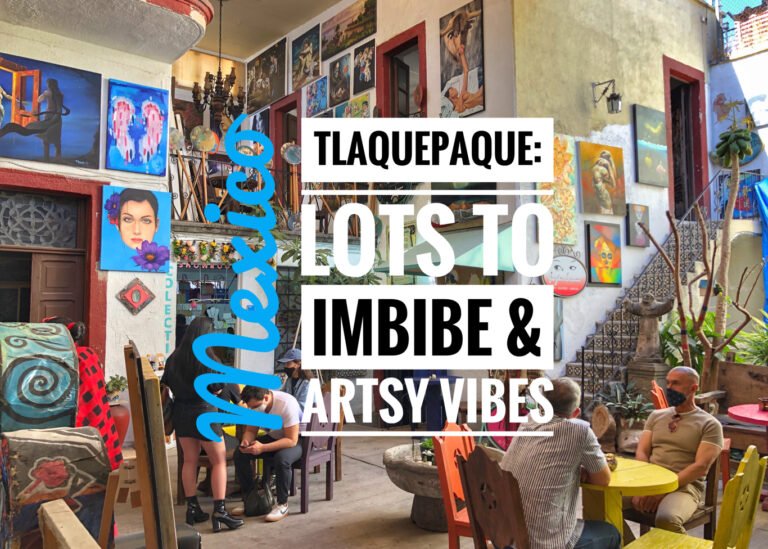
We came to Peru from Colombia basically because we wanted to experience it, particularly Machu Picchu, before all the crowds return following COVID. While this had proven to be pretty successful, we knew that planning our trekking routes would be a little more challenging considering it was low (aka rainy) season, which runs from December-March. However, we also read that March wasn’t nearly as bad, so we juggled our itinerary to ensure we’d be going as late as possible during our two month stay.
That was…not effective…to say the least ?. During our five day/four night independent trek on the Salkantay Trail we got pummeled with it all…frigid rain, wind, snow and ice, all while plunging through interminable tracts of mud, countless river crossings (many without shoes), and endless challenges with landslides and closures.
To top it all off, Mandy sprouted a new “friend” called a bunionette (or bunionito, our Spanish variation). This little asshole decided to hitch a ride on her right foot and wreak havoc on what was already a demoralizing experience.
Needless to say, we felt greatly humbled and more grateful than ever after this adventure. Grateful for a warm bed, for hot tea, for pampering socks, steamy showers, for food…any food to fill our tanks. We were also grateful we had the opportunity to bow out on day four for a little pleasure in some phenomenal hot springs in Santa Teresa.
Day 1/Part 1: Cusco>Limatambo>Mollepata>Soraypampa

So why did we choose the Salkantay Trek anyways? Sure, we could have chosen the popular guided Inca Trail, but that would involve dropping at minimum $600/each. Or, we could have taken a guided trek on Salkantay for a minimum of $500/each. Since both of these would nearly blow our entire $1400 monthly budget, we knew going independently on the Salkantay Trail was the best and most budget friendly fit for us. And, it would have been…IF we had chosen not to do it in March. Normally good trekking seasons are something we plan around, so this was a BIG boo boo. However, we are happy to report, budget-wise it was a win and we spent 760 sols, or $203, for the trek.
But first we had to get there. And we learned early on buying our Machu Picchu tickets, that the Peru Tourism People make nothing easy for the DIY traveler. They seemingly have a ploy to wear you down so you just toss up your hands in defeat and say, “Está bien, here’s my MasterCard! I’ll take a tour!” But, no siree would we be conquered. The day before we left, we went to a location marked “Buses for Mollepata” on Google maps to try and get departure information on colectivos to the nearest town to the trail.
Well, apparently our Spanish failed us because we both heard something different although we both heard “no pase” but couldn’t grasp the context because the guy wouldn’t notch down his Spanish for the gringo Spanish students. Mandy thought the bus was at 5 am and Greg, at 5 OR 7. Fortunately, our host confirmed the buses leave from 5-7 am, so we chose to Uber to the bus stop at 6:00. Unfortunately, when we arrived, we learned the colectivo actually left at 5 am, so our only option was to wait until 10 for the next colectivo, or to go to another nearby town called Limatambo. Again…we also heard those concerning words “no pase.” Reluctantly, we hopped on the van to Limatambo knowing we could figure it out when we arrived.
Arriving to Limatambo around 7:30, we asked multiple people when another bus left for Mollepata and the consensus seemed to be something around 12:00 and again the words “no pase!” Eventually, we realized the road to Mollepata was closed and would only open at 12:00. So….we had about 4.5 hours to kill in little Limatambo.

Limatambo is evidently a proud exporter of the hass avocado, which are confusingly called paltas in Peru, (not aguacates like the rest of the Spanish-speaking world we’re familIar with.) They are so proud of their avocado, their town trash bins even boast their claim to fame.

And of course the rains appeared. We hid out under a tree in the main square.
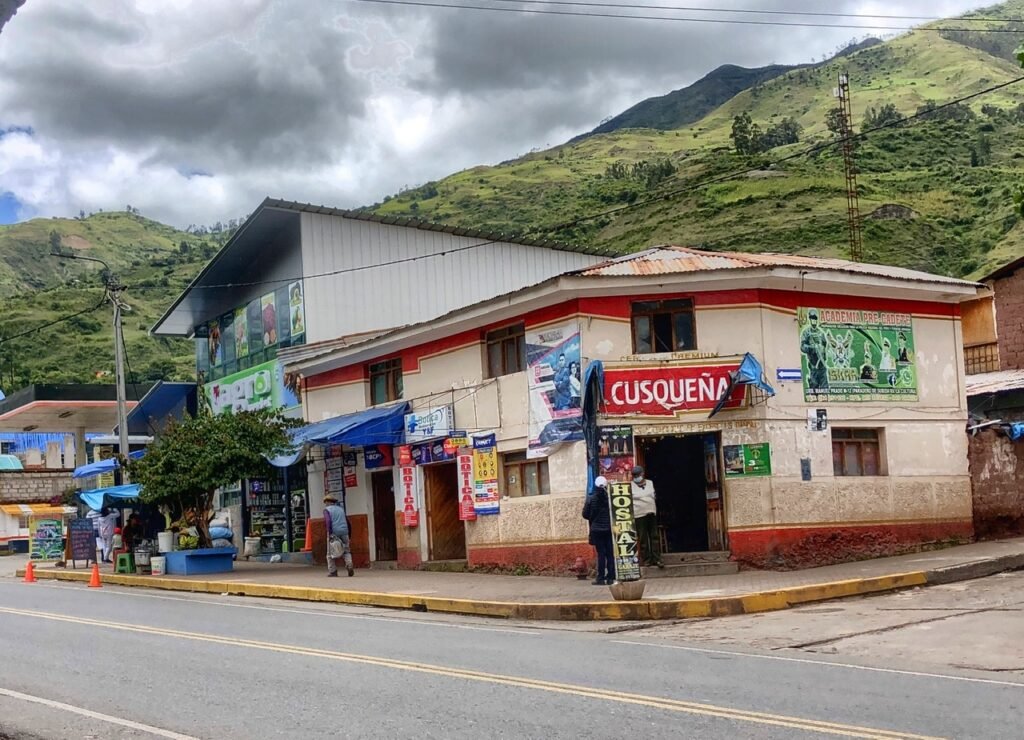
After a massive second breakfast for 6 sols ($1.50), it was 11 so we sat at the bus stop to wait for our ride to Mollepata. Fortunately, as we waited, we asked multiple people if we were in the right place and received positive affirmations.
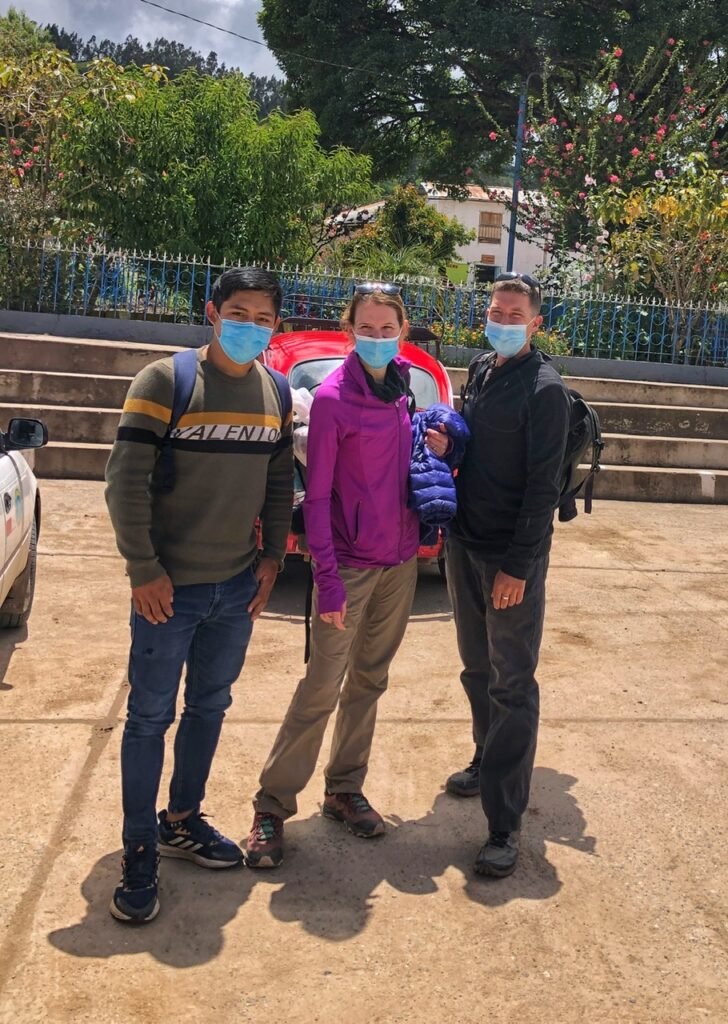
However, by 12:15 no colectivo had come. Our luck began to change at that moment because a university student came over to ask if we wanted to share a cab. We had previously been quoted an absurd 160 sols ($43) so we jumped at the chance knowing he’d get us the local rate. Sure enough, the charge was 30 sols total or 10 each ($2.50). We chatted with our new friend Jose in Spanglish throughout the 30-minute drive and learned quickly that the road opening at 12 actually only allowed traffic from 12 to 1 due to construction. Ah, the meaning of “no pase….” In short, Jose saved our butts. Thus, we happily paid the full amount upon our arrival to Mollepata.
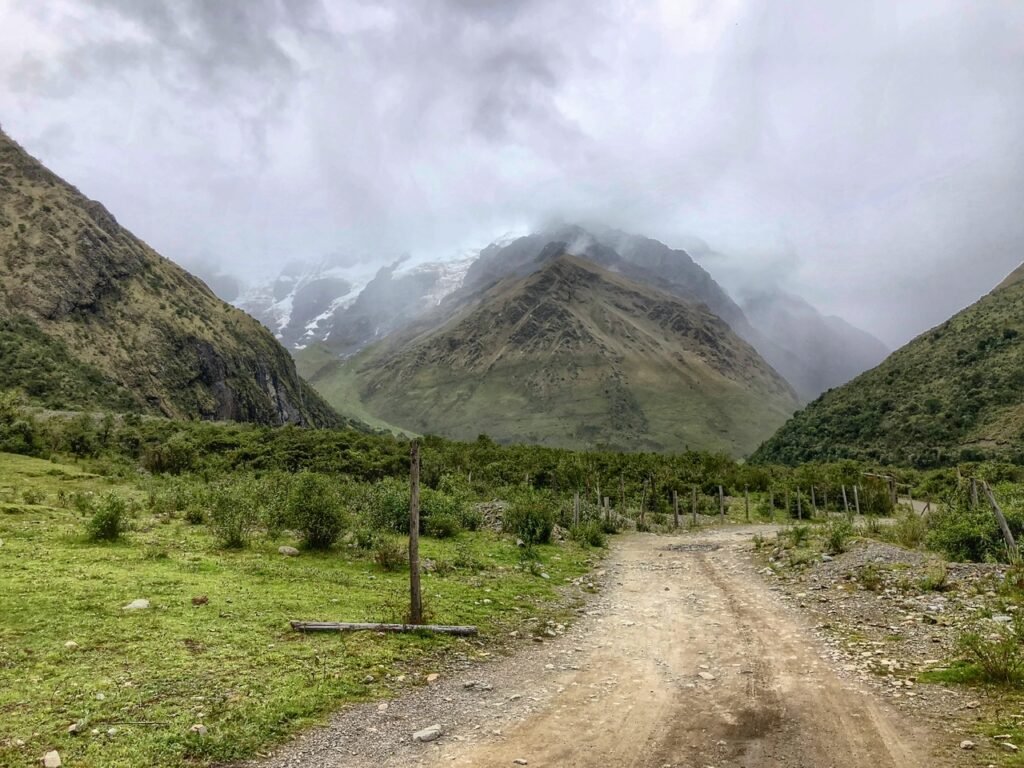
When we arrived to Mollepata, we still had an hour up a quite looping and knobby path to reach our final destination of Soraypampa. Another stroke of luck graced us when a cab of two Barcelonian gals asked us if we wanted to share this next ride, which saved $10. Whoohoo!
However, we instead got to pay a 20 sol ($5) per person entry fee for Humantay Lake.
When we tumbled unsteadily out of the car, we were more than ready to walk the final leg of about a mile into the community. It was also then we felt our rain drops decided to join us. Perfect.
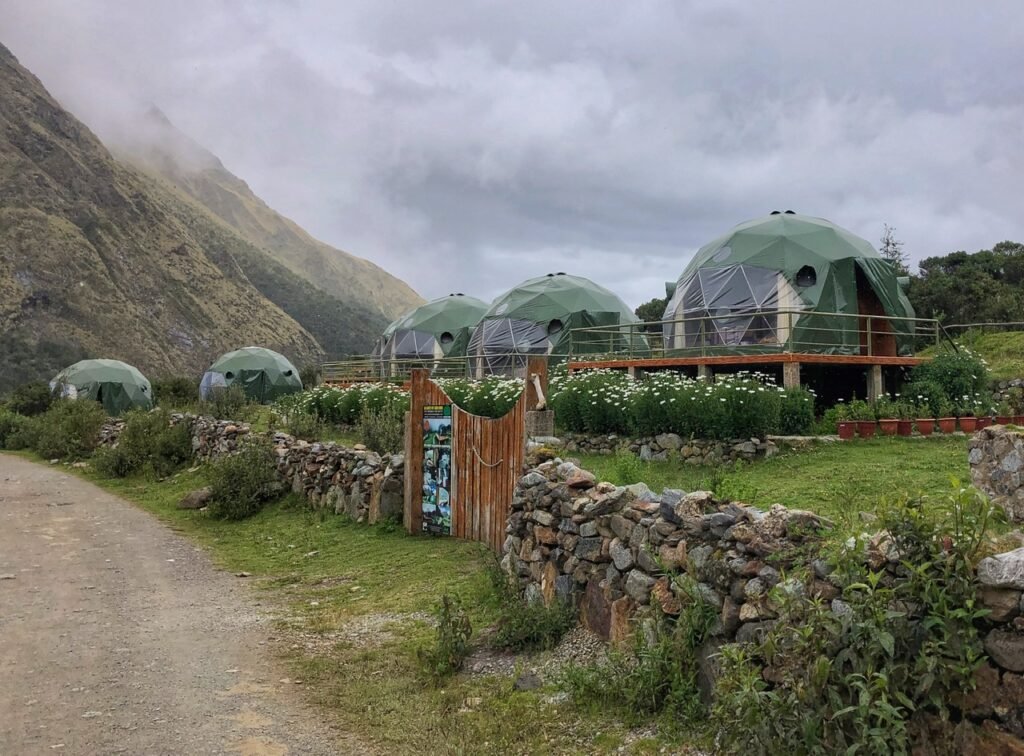
There are typically three types of accommodation options on the Salkantay Trek. The top end is an ecodome, which can set you back around $50-$75/night.

The bottom end (other than regular tent camping) is a camping shelter which just provides coverage from wind and rain. Of course, you need a sleeping pad and bag for these. Also, they appeared to be either closed…for good, or for the rainy season.
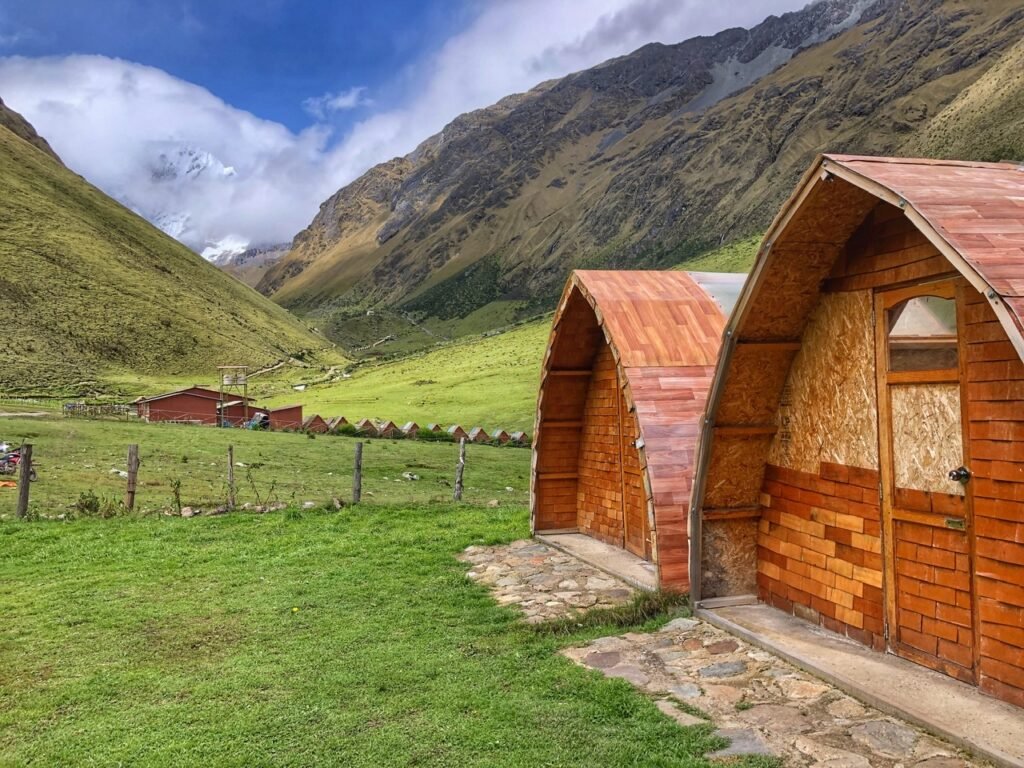
Since we don’t travel with these things, we were happy to choose the middle level, which was a little plywood hut. The hut cost 140 sols ($37) for both of us, and included dinner and breakfast. This was by far our most expensive accommodation of the trek.


Our hut also included an unfortunate-looking, but miraculously functioning USB jack, a comfortable bed, one pillow for us to fight over (fortunately we always have our own Fillo camping pillows), and a skylight ceiling opening onto the stars (or pounding rain in our case.) This was unquestionably the coldest night of the journey, as we were at 4150 meters (13,615 feet).
Day 1/Part 2: Humantay Lake

After we settled into our plywood box in Soraypampa community around 3:00, we set out on our next escapade. This was to hike about an hour up the wee mountain outside our door to Humantay Lake, a dazzling turquoise jewel, which is a common day trip from Cusco. No sun rays made her radiate in full capacity, but amazingly the rains held out and we were able to thoroughly appreciate this beauty wedged between Humantay and Salkantay Peaks. This lake, which was once sacred to the Incas, is still considered spiritual by Shamans and spiritual travelers. We loved how the massive arresting glacier blends harmoniously with the lush green mountain and hypnotic waters.
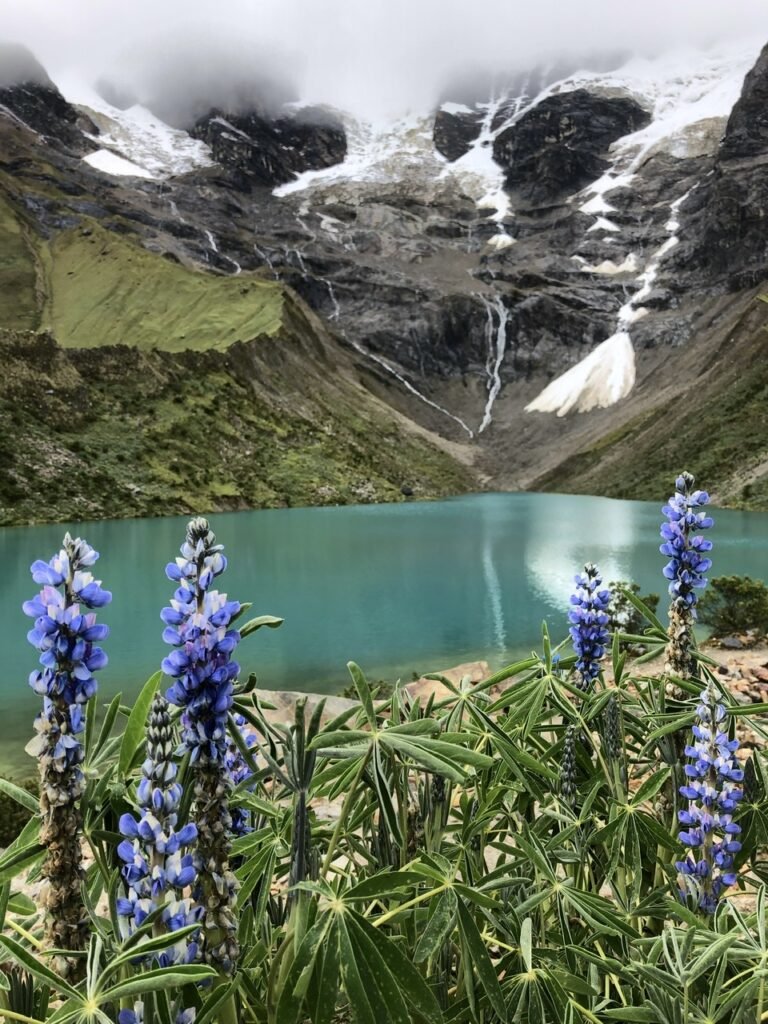
And because we were here during spring (one advantage of March), we were able to appreciate the popping lupine.

Mandy feeling victorious after day one. This was before she took her shoe off later that evening…
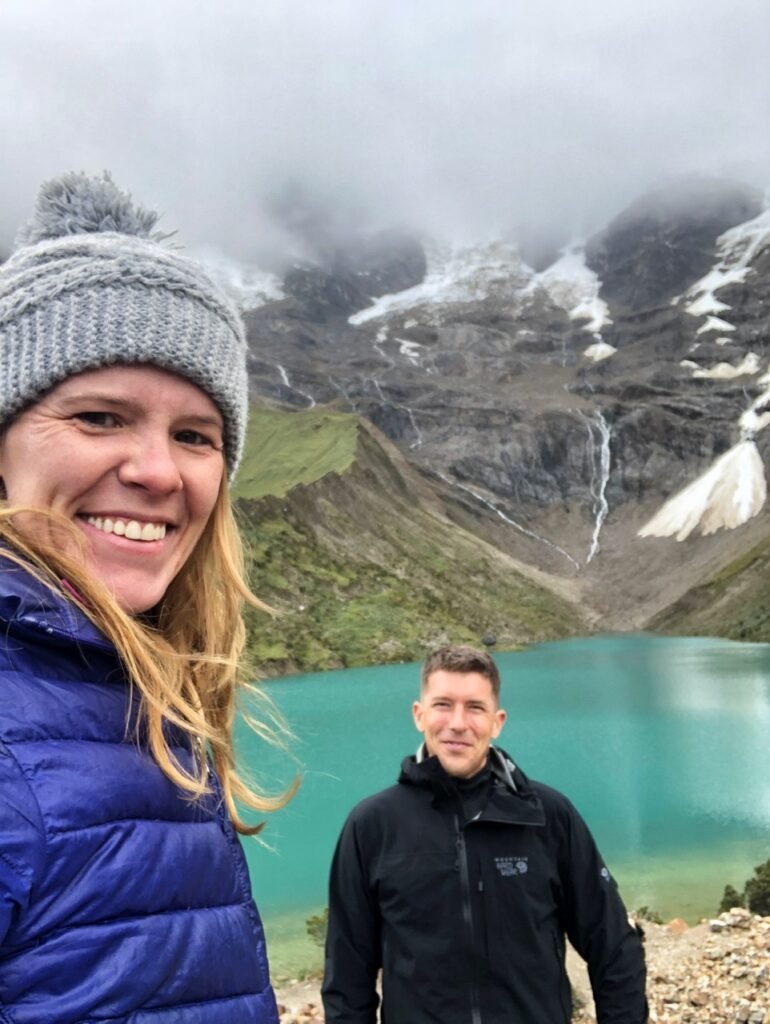
Definitely the highlight of the day.
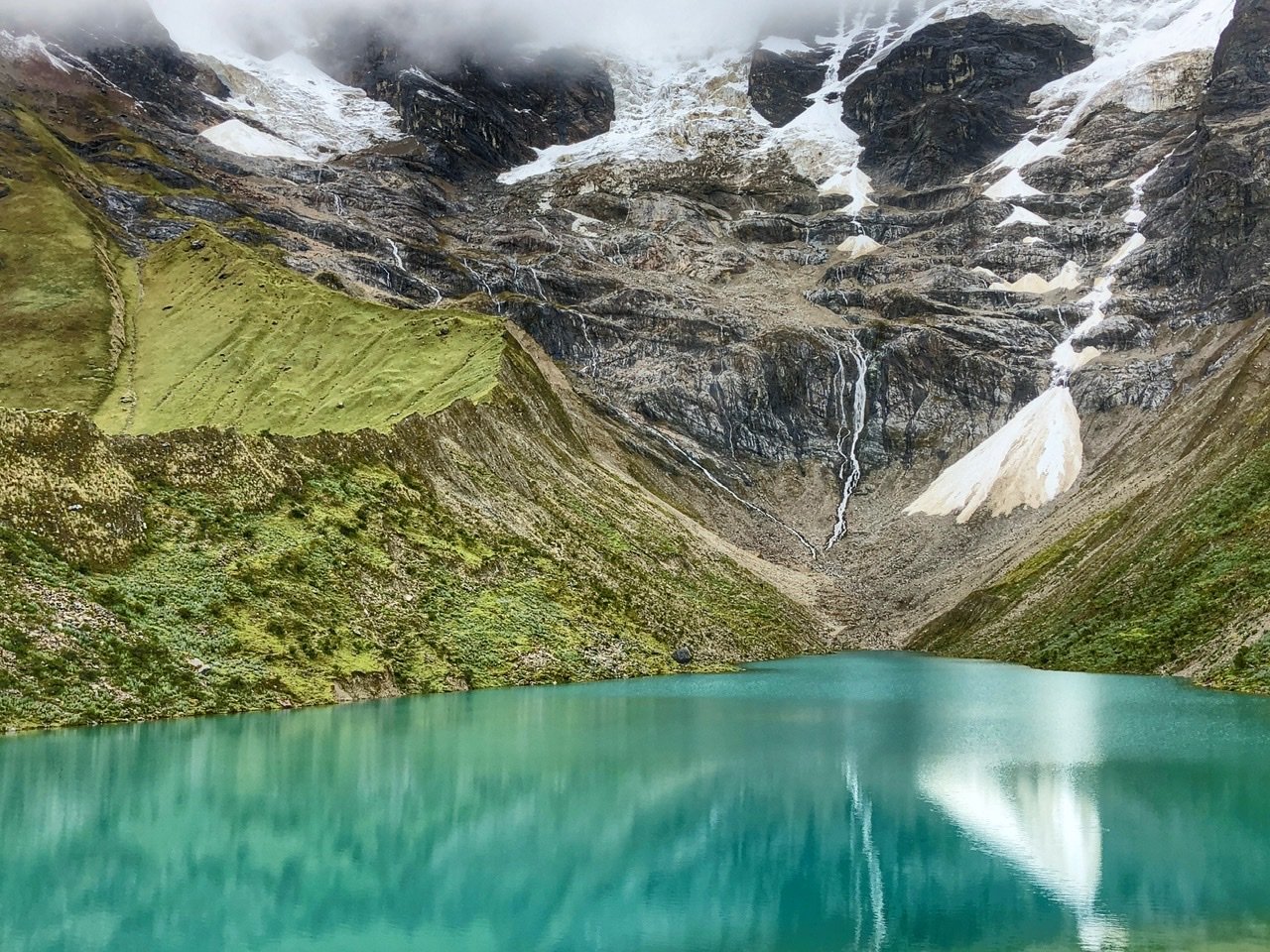

Check out the reflection of that glacier!
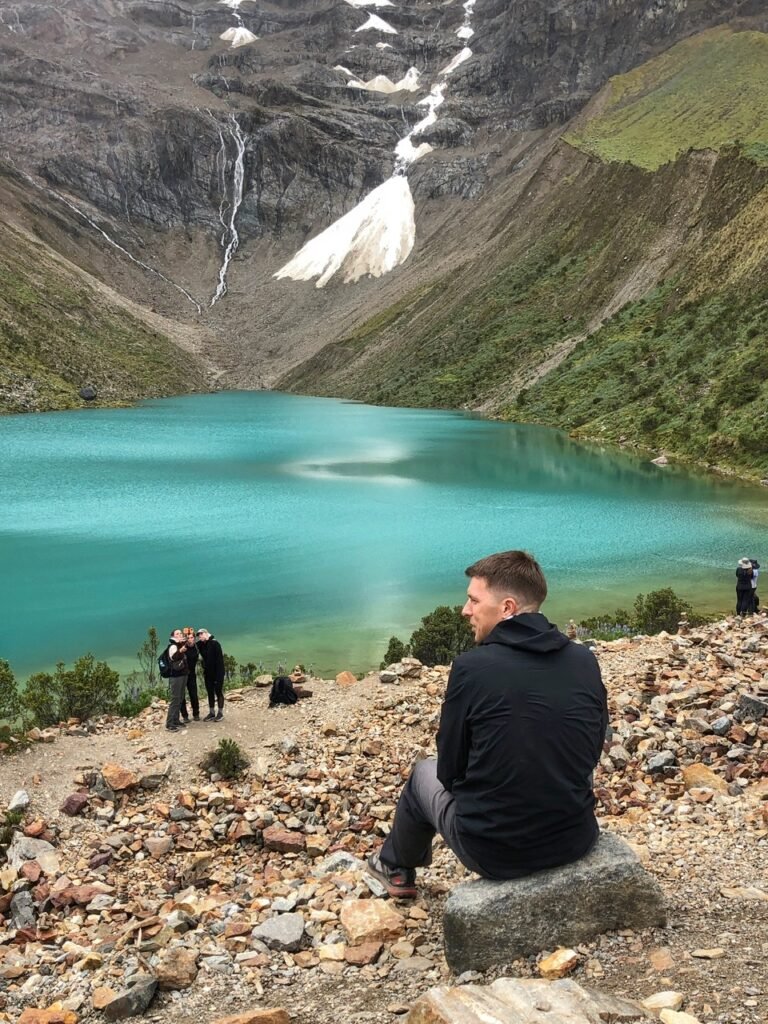
Greg wants his own photo, but some selfie stick chicks had camped out in an inconvenient place.
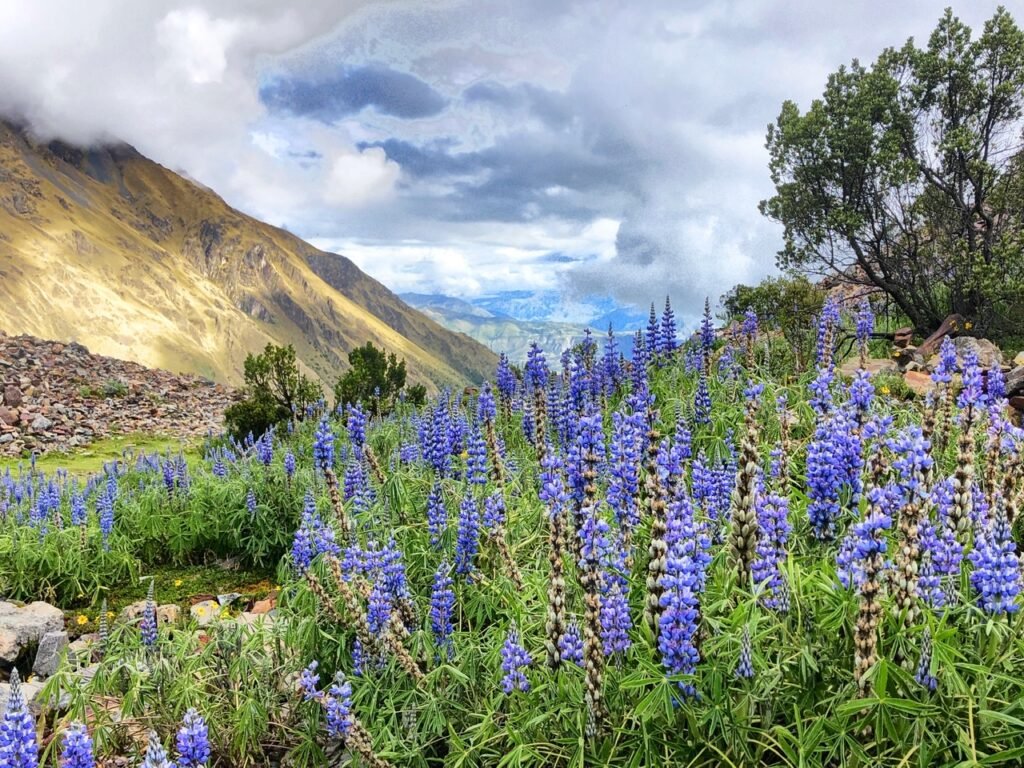
Gazing the other direction, there was actually a bit of blue….
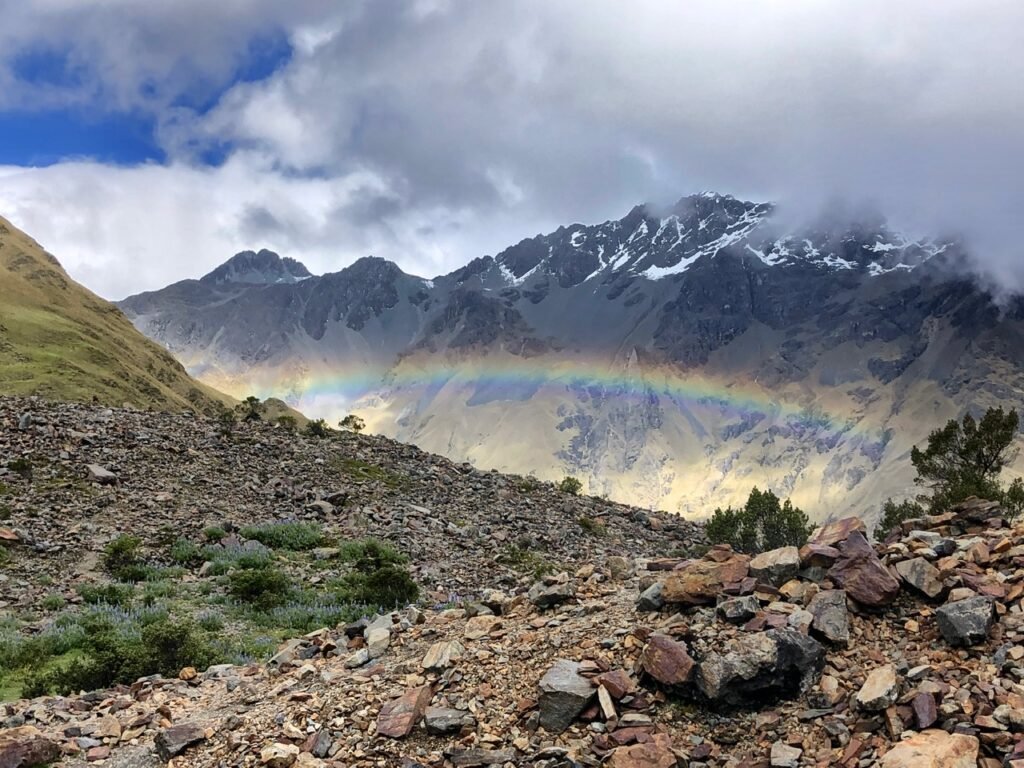
…enough to form this ravishing rainbow over the valley.

The hike up and down from the lake is very pleasant in scenery, but certainly pays to be well acclimatized.
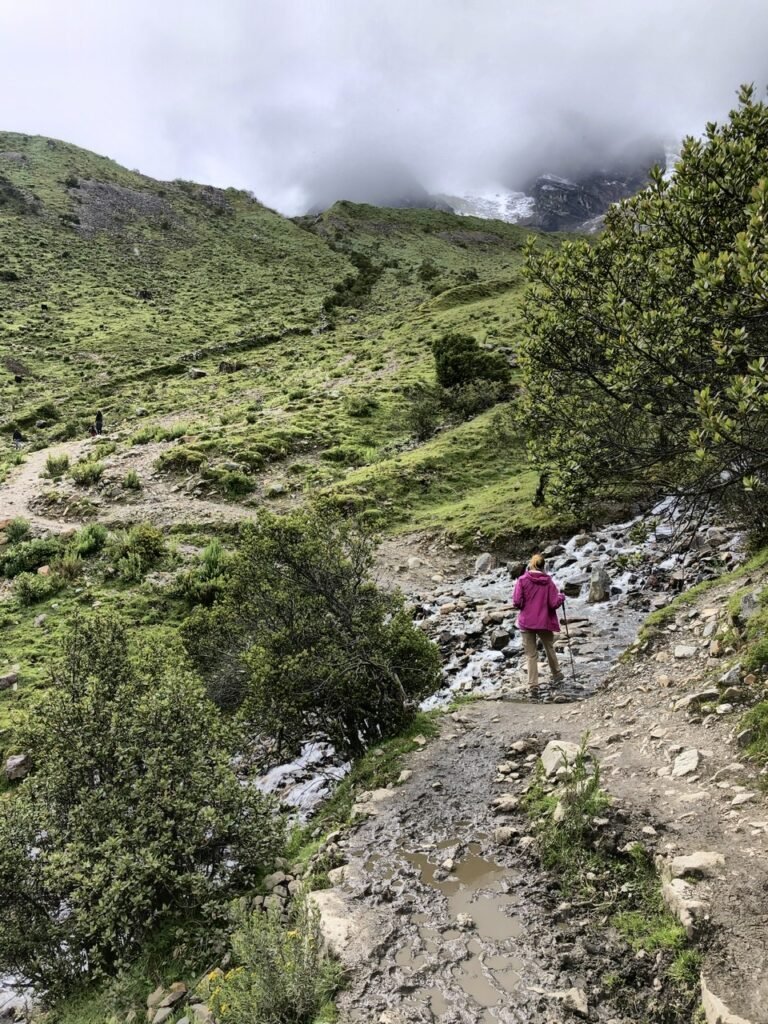
It’s quite steep so basically like climbing stairs for an hour. Fortunately, we didn’t have issues with altitude, although we witnessed several people who did. Mandy, did, however, take altitude pills as a preventative measure, which you can buy OTC very cheaply at any pharmacy in Peru.
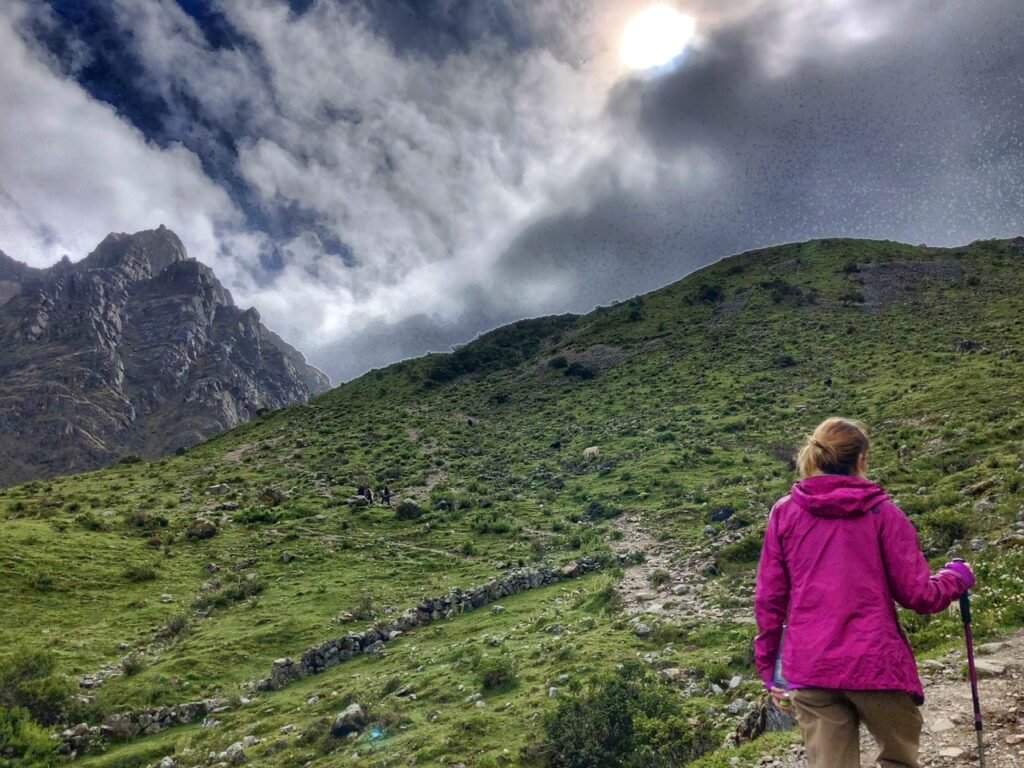
We were so happy not to get rained on, despite the swirling sky. But our luck was to run out very soon…

Mandy pausing to chat with a local, named Rosa, on the trail. Rosa, despite being around 60 and from the coast, charged up the mountain with no issues. Clearly, it’s in her blood. For us, it was a little more effort!
Day 2: Soraypampa>Chaullay

We’ve trekked…a LOT…but the first “official” day of the Salkanatay Trek proved to be the most challenging day of hiking we’ve EVER endured. Day 2 began after a mostly sleepless night in our protective little boxed home. The wind and rain had whipped relentlessly throughout the night, as we kneed and snuggled into each other under a mighty mound of blankets. Also, we discerned someone wretching outside our door, most likely due to altitude sickness, a common problem over 3500 meters meters (~12,000 feet) which fortunately did not inflict our bodies.
We awoke not to pounding rain, but a consistent drizzle just spirited enough to don our ponchos after about 30 minutes of maneuvering through mud pits and horse caca immediately outside of the community of Soraypampa. It’s kind of comical looking back because at that point in the trail we were still delicately and actively trying to avoid mud and getting our feet wet.
From this moment, we should have been able to bear witness to the colossal Salkantay Peak before us…the 6271 meter (20,574 feet) snow-capped motivator whose pass we would amble through later that day. Unfortunately, the 25-kilometer (16 mile) day featured no scenic motivation whatsoever. It’s like being face to face with Denali and seeing nothing. Only tumultuous skies, poor visibility and the constant drizzle eventually turning to snow and ice as we ascended nearly 1000 meters or 3,000 feet.
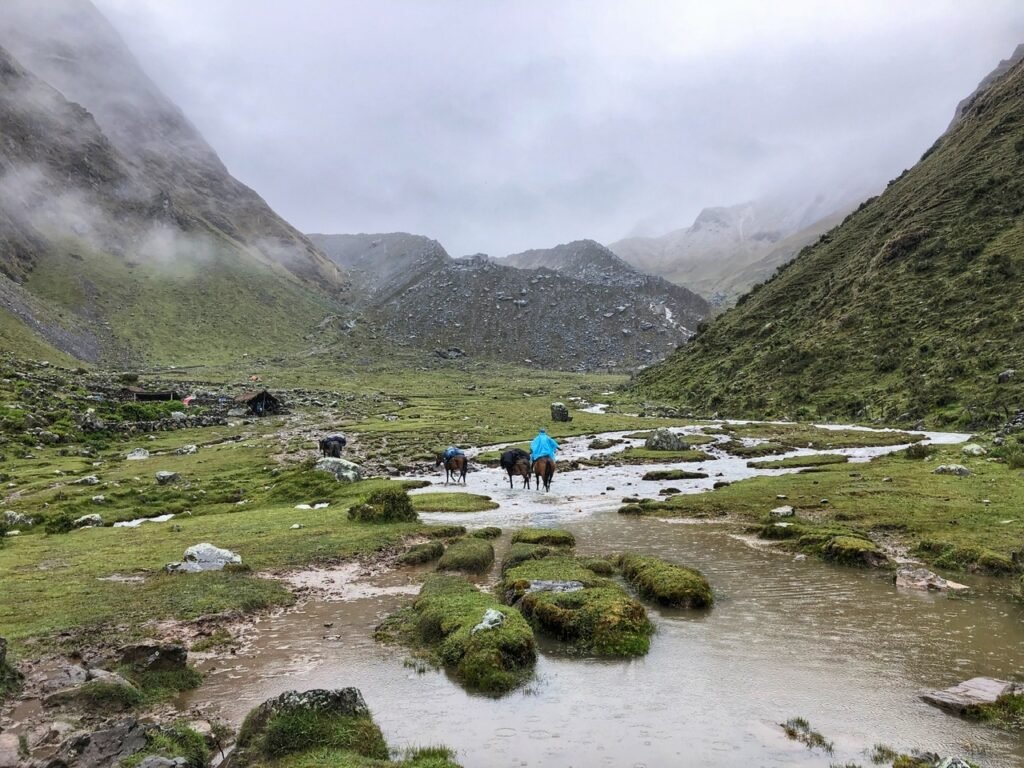
At this point, we were clustered together with the backpacking herd from our overnight stay and many groups of locals with horses heading to their fields. Unfortunately, this was a big problem we found with the management of the Salkantay Trail. The horse and foot trails were one in the same. This means extra mud, extra sludge and lots and lots of crap.
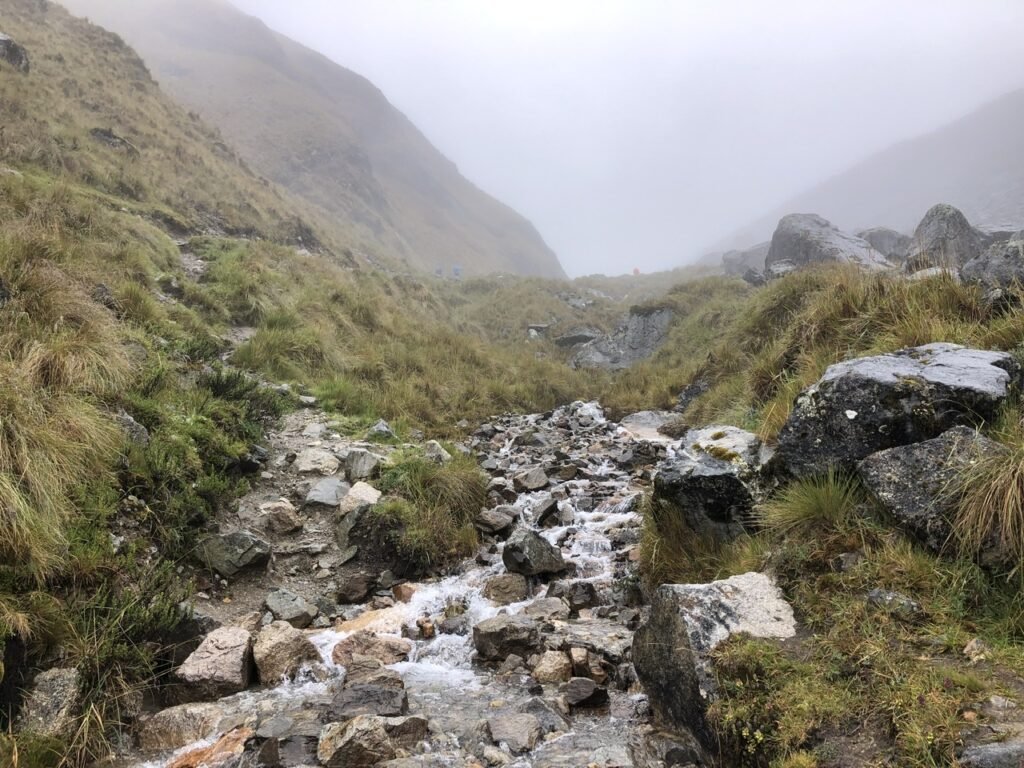
And more water and mud crossings then we could count, some with carefully placed stones to leapfrog across, but most with only a make-your-own adventure kind of approach where you inevitably landed with at least half a shoe caked in mud, shit or some combination thereof. During the four-hour ascent, our phone mostly stayed tucked in our pocket to avoid flooding it and because all we could do was focus on was breathing the thin air and putting one foot in front of the other. Not that there were any pictures to be had, anyhow. To add to the fun, by this point, Mandy’s foot where the bunionito had sprouted was already aching. But we had no choice but to continue on. And, despite our uphill trajectory, it was getting SO cold….

Mandy manages a (fake) smile at the top of the Salkantay Pass at 4,635 meters (15,200 feet.) It was here we gazed longingly at the guided backpacking groups wrapping their mittens around $400 toasty cups of hot chocolate as we nibbled our walnuts and cashews. And it only got better (ha!) as we crested the pass…the bitter wind shifted and began blowing ice and snow crystals directly into us as we began our 1914 meter (6279 foot) descent down the mountain.
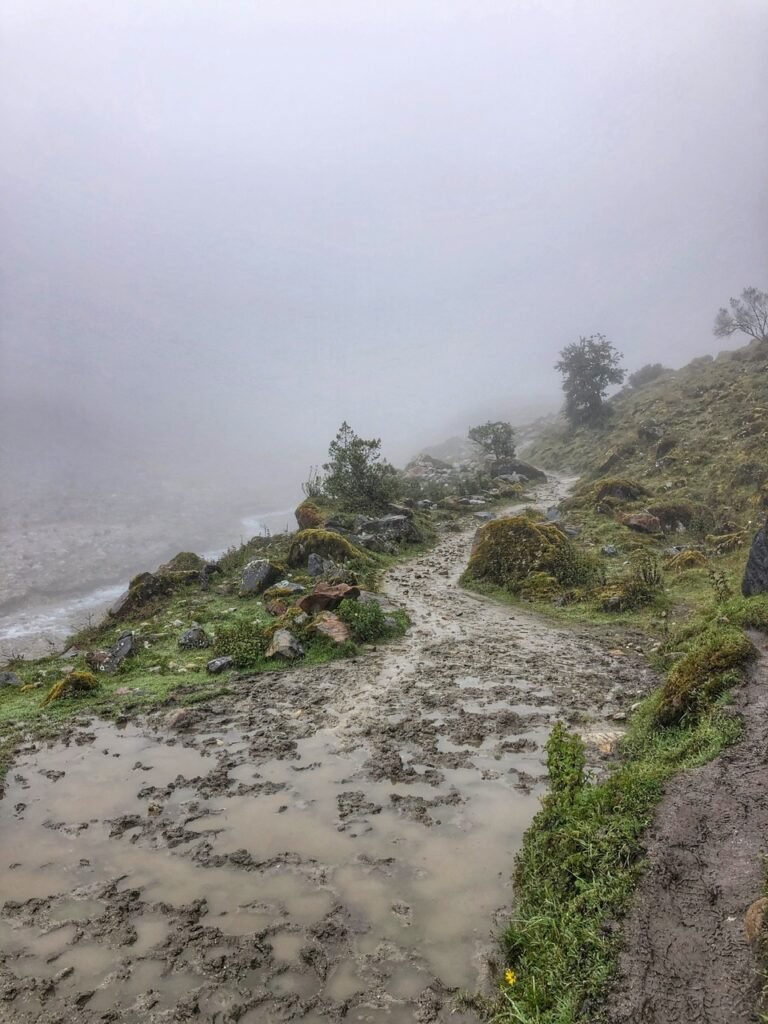
And although our toes and fingers started going numb, every step became more and more excruciating.

About three hours from our final destination, we came to our first full-fledged water crossing. By full-fledged, we mean there was no way to cross it safely, other than slopping directly on through. So from this point forward, our shoes and feet were also utterly doused, despite the manufacturer’s waterproof proclamations, creating a pruny, trench-footy, and bunion-y disaster (for at least one of us.)
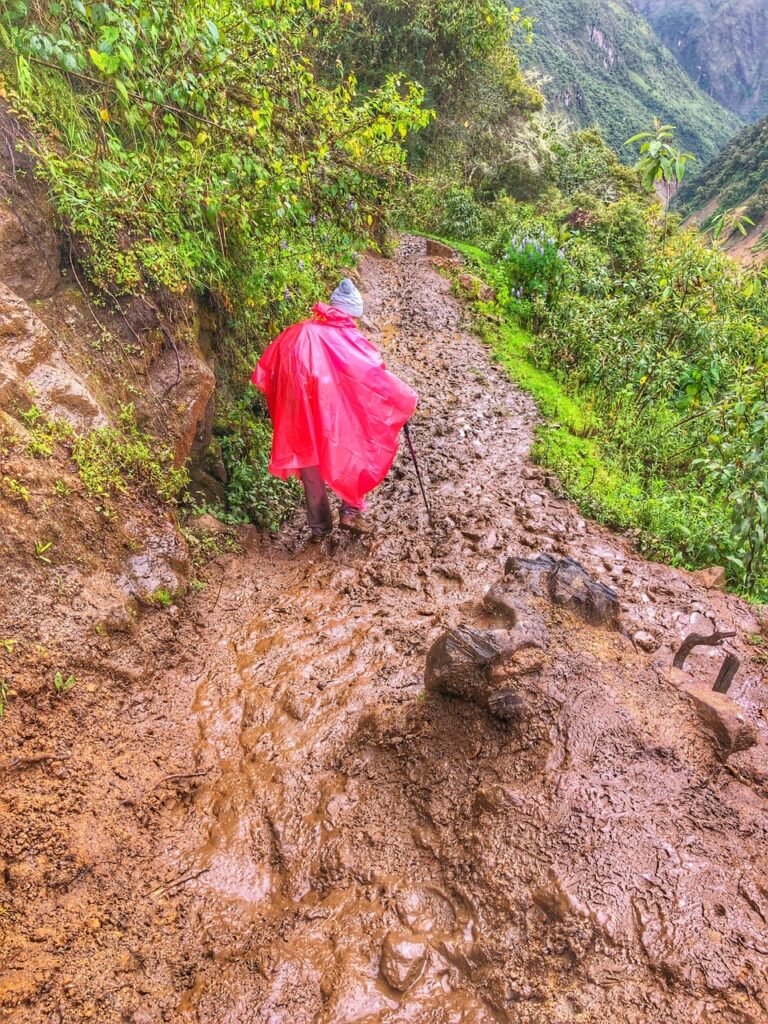
This was one of the longest days…maybe ever.
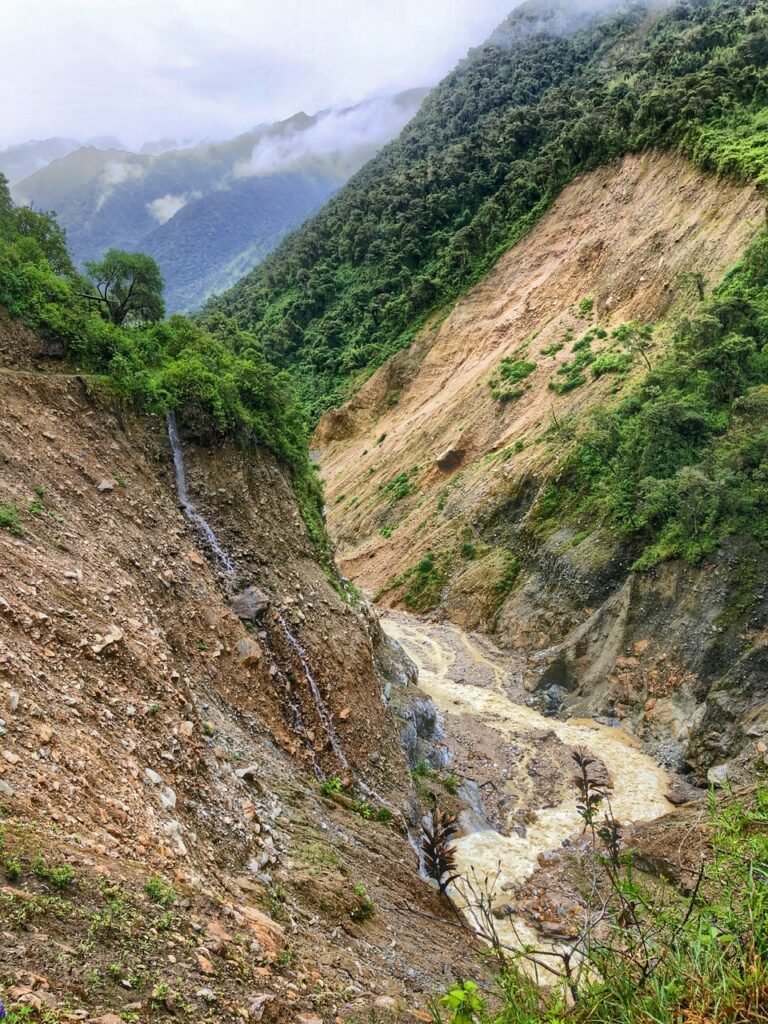
Eventually the rain tapered off and the clouds began to part revealing a brown churning mess of a river.
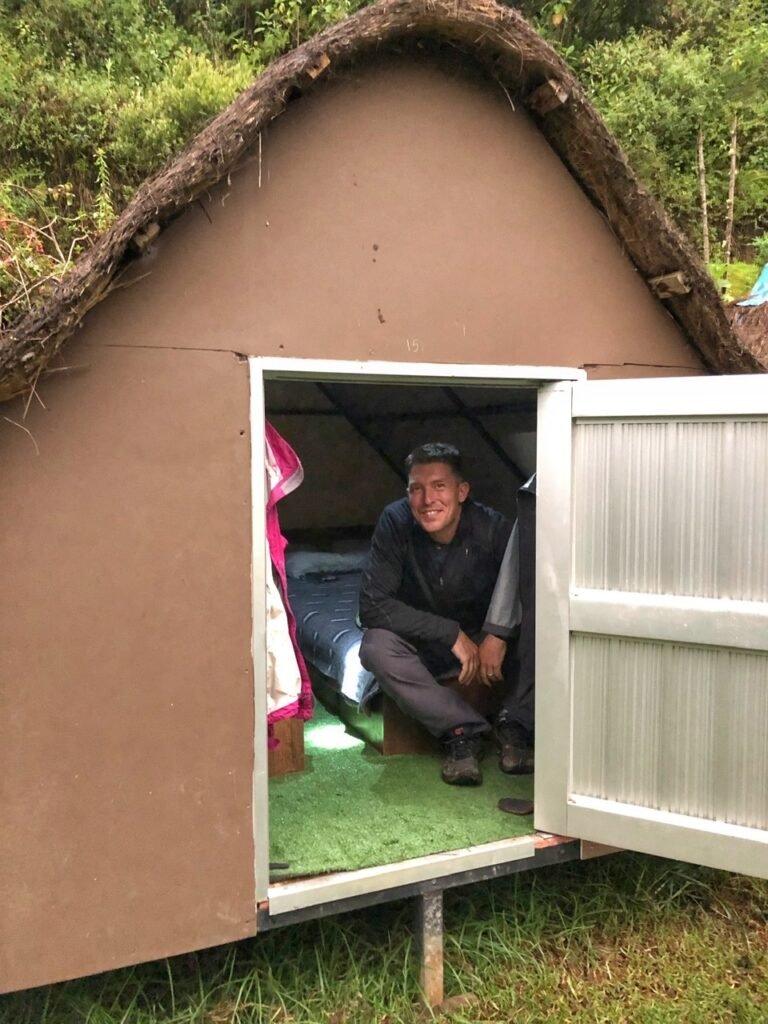
We couldn’t have been more relieved to arrive to our destination, the little community of Chaullay at 4:45, ten hours from our departure time. We were famished, frigid, and pained. Thus, we graciously accepted the first available place we stumbled, quite literally upon, which reminded us of an Icelandic chicken coop. Coop or not, we were able to change out of our wet clothes and start the great thaw. Cost for the coop was 80 sols or $20, which included dinner and breakfast for both of us. We didn’t get a lot of blankets so we decided to double up in one bed so we could stay warmer.

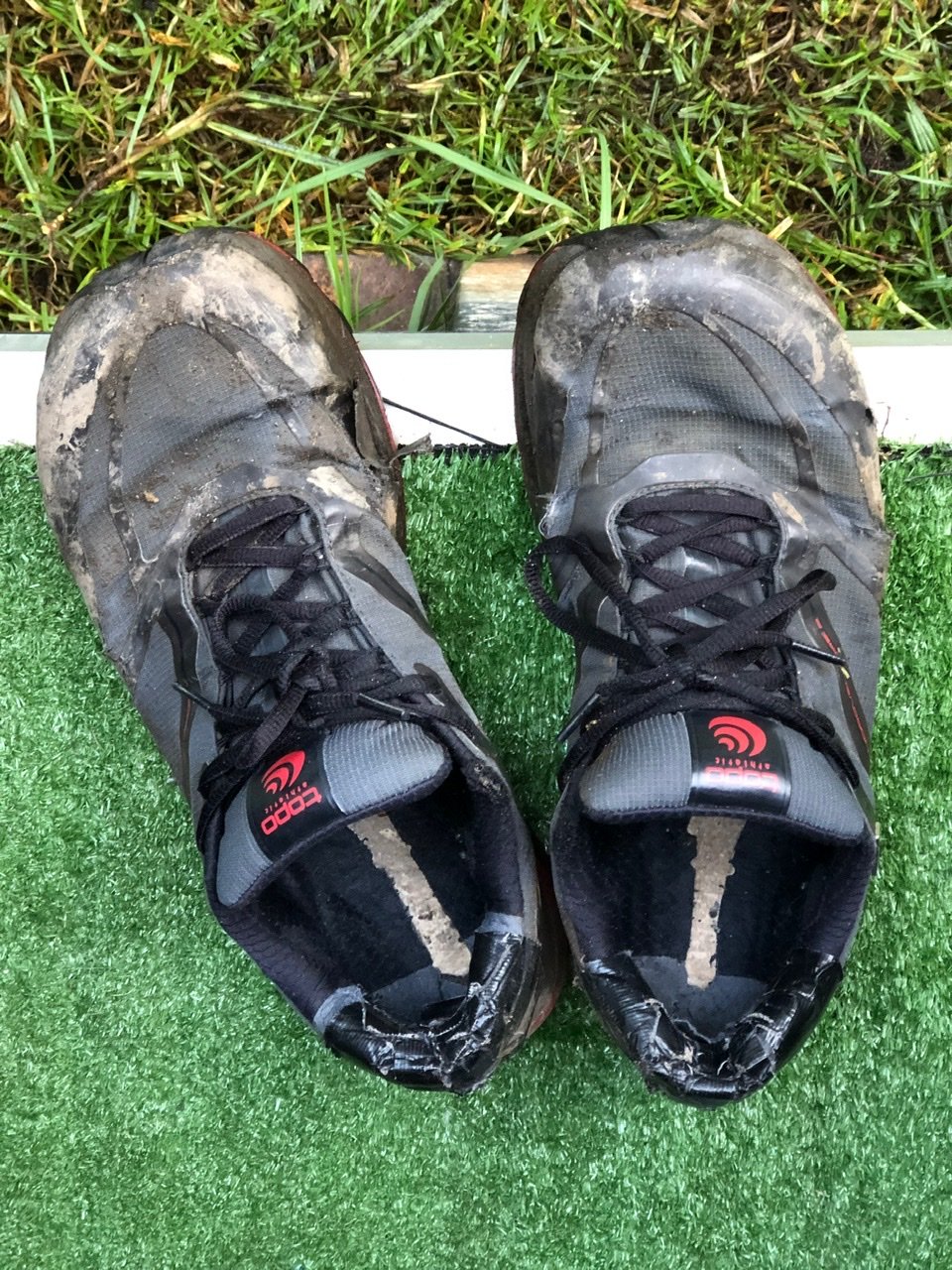
Mandy nursing her foot after the doozy of a day. You can see the bunionette (also known as a tailor’s bunion) protruding from underneath her pinky toe. Although she has been wearing these shoes for eight months, this is the first time it gave her serious problems. This is why it is IMPERATIVE to buy shoes that actually fit your feet! In other shoe news, Greg’s Topos at right were definitely on their last rodeo, but surprisingly didn’t cause any major problems.
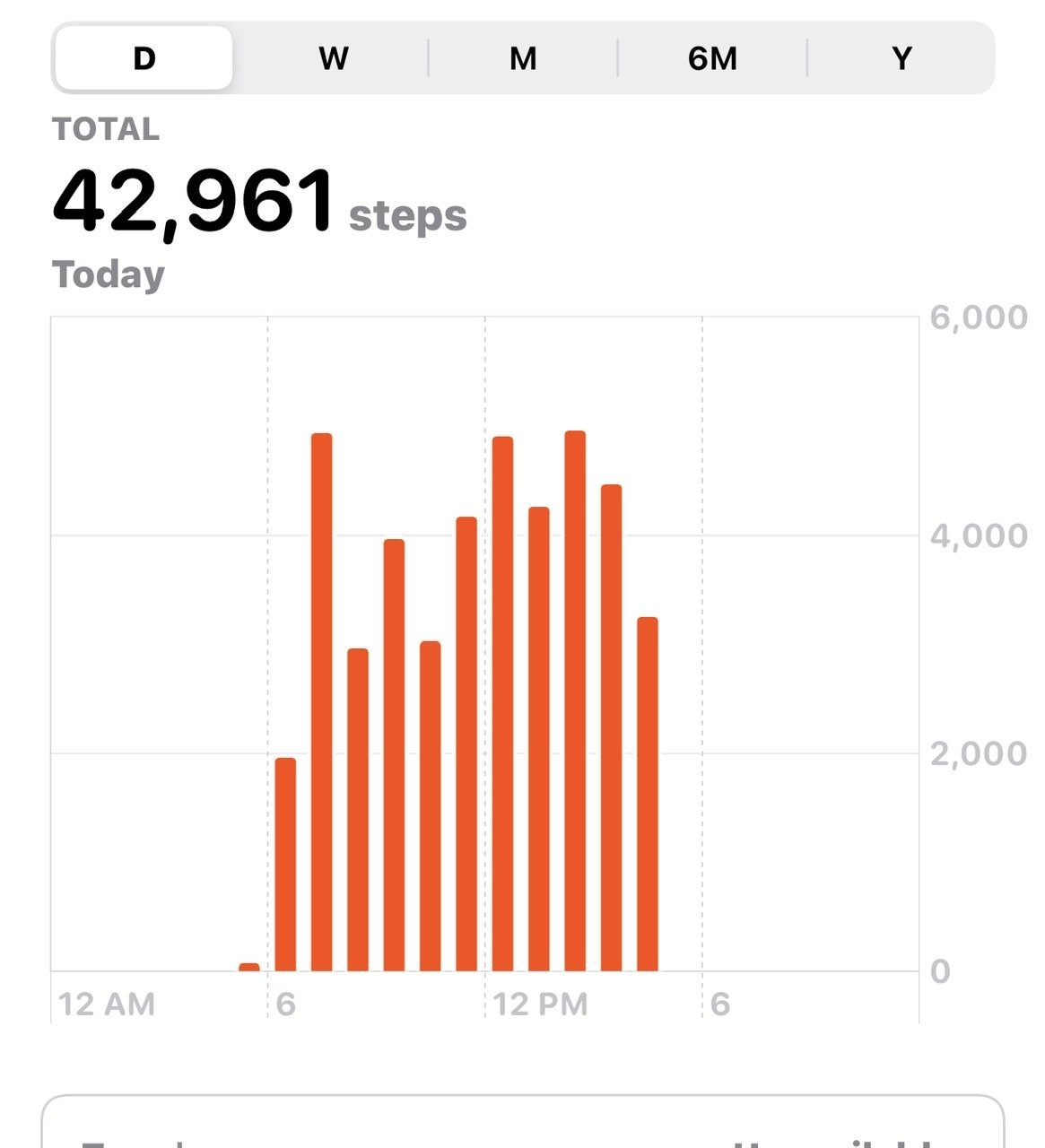
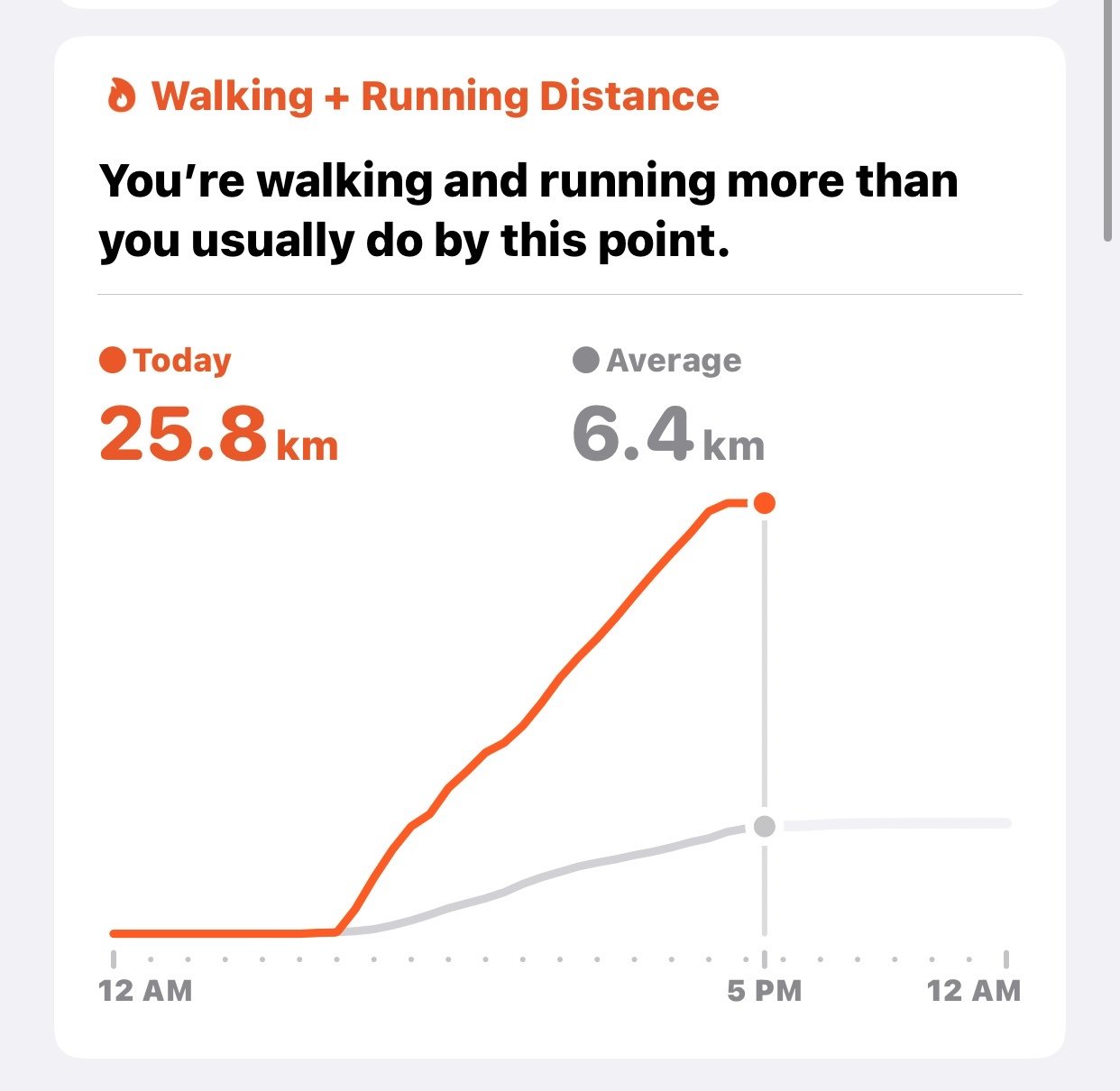
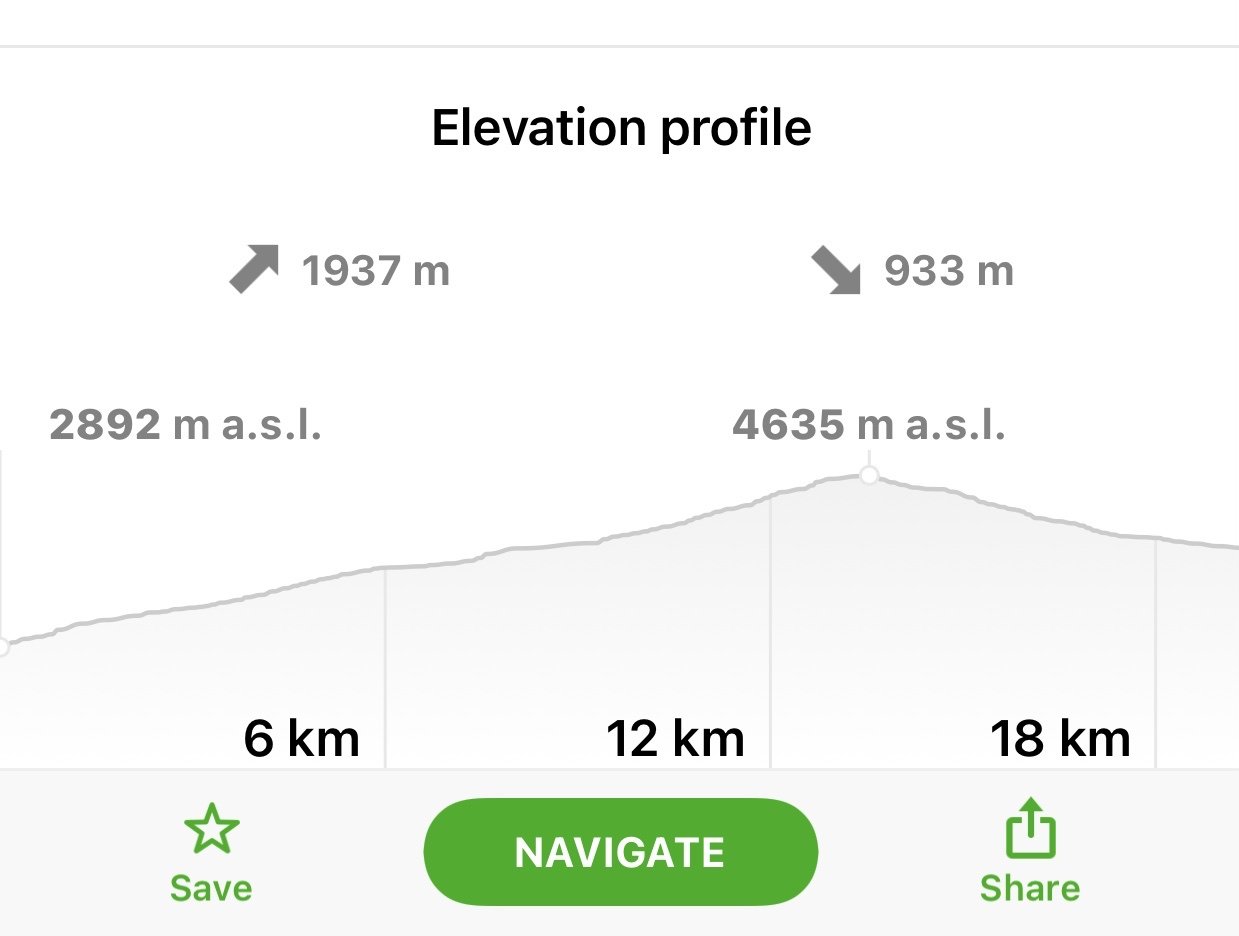
Our stats for Day 2.
Day 3: Landslide Day: Chaullay>Sahuayaco
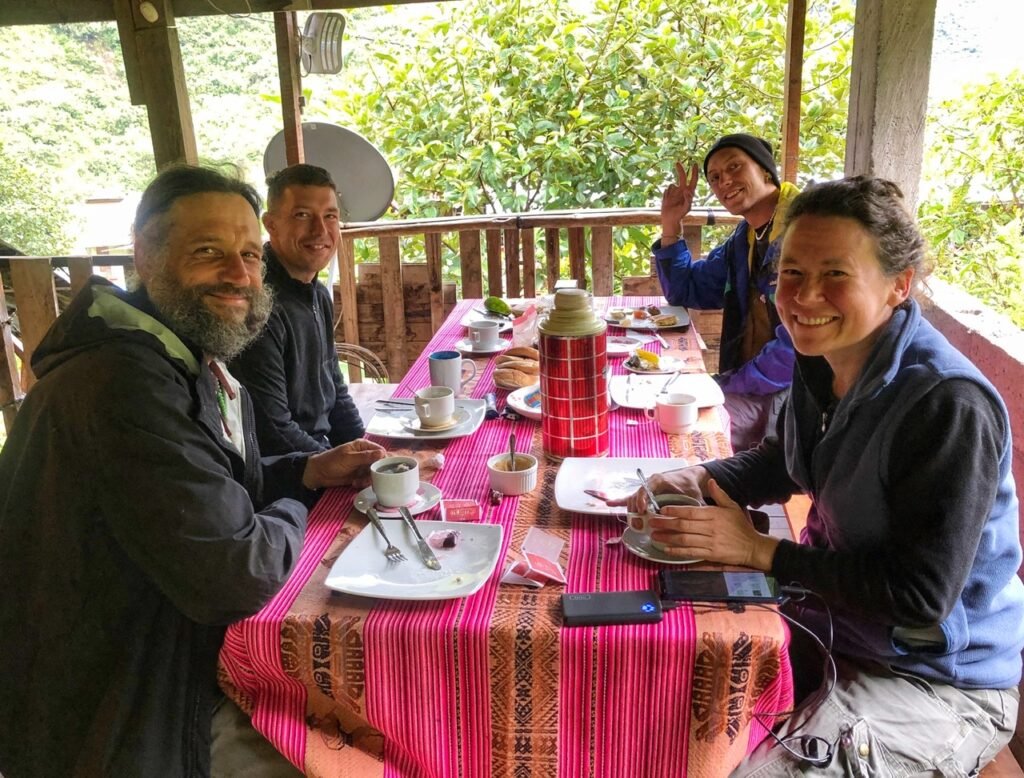
Day 3 of the Salkantay Trek began a little bit brighter, both figuratively and literally as the sun managed to peek through the clouds upon our little Icelandic chicken coop. Based on the pain and suffering from the previous day, we had made the decision to bail on the hike at the next possible opportunity in the village of Collpapampa, a mere 25-minute hobble away. It was there, we were told, a colectivo could take us to Santa Teresa, a town with a reputation as a hiker’s respite with accommodations, happy hour specials and hot springs. Sounds great! ??
Unfortunately, such a colectivo did not exist thanks to a series of landslides and closed roads. Our fate for day 3 was solely (pun intended) on foot…20.2 kilometers (12.5 miles) to the next village of Sahuayaco.
Of course, we were oblivious to the day’s destiny when we plopped down to have breakfast that morning. We just basked in our new optimistic outlook, Mandy’s somewhat healed foot, and the new friends we met, named Melissa and Pavel who happened to be from…Portland, Oregon! (Our last official home.)

Breakfast (which was included in our accommodation cost, along with dinner for 80 sols/$20)

Our first river crossing for day 3, naturally, was only about 10 minutes from Chaullay. After trench foot setbacks the day before, this time we smartened up and removed our socks and shoes first before plunging them into the frosty waters.
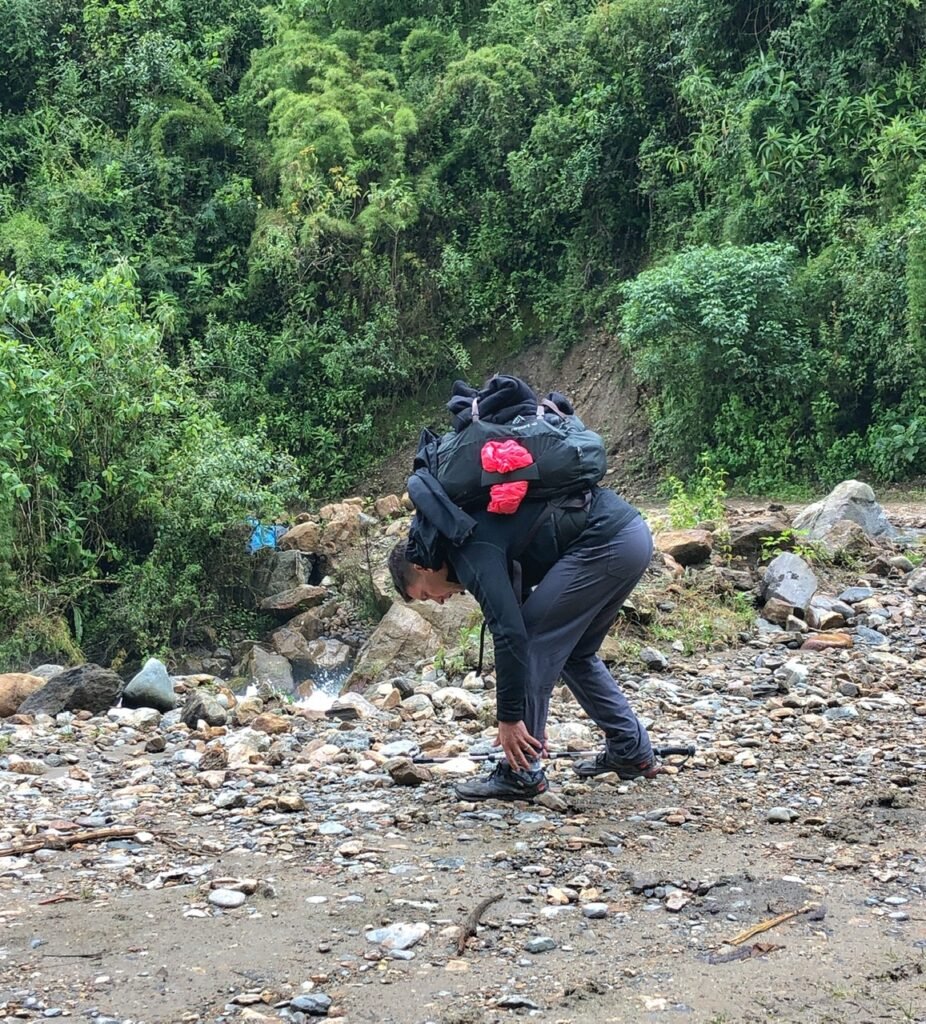
This was a process we would go through at least eight more times over the course of that day.


We were so delighted to actually see some scenery as we ambled away from Chaullay, including endearing little patches of blue sky. Yay! Good to remember why we love hiking!

And the luscious lupine was EVERYWHERE! It was going to be a GREAT and healing day and we were almost to Collpapampa, where our chariot would await to Santa Teresa. When we arrived to Collpapampa, a one-road kinda village, we saw a van resembling a colectivo and flagged down the driver. He muttered some words we definitely understood from day one…”no pasé!”
After a little more digging and Spanish puzzle piecing, our hearts dropped when we realized the road was closed for at least five more kilometers to the next village. The village was not on our Mapy app and was named something indecipherable starting with a “G.” We soon began referring to it as Gallina, meaning hen, which quickly morphed into “Chicken Town.” (Hey, there’s not a lot to talk about on the trail when you’re miserable but trying to be happy!)

We walked about 4 kilometers and found out exactly what was meant by “no pasé” this time. A dump trunk which had gotten stuck in the middle of the very narrow gauntlet which was naturally teetering on a precarious cliff. Three of the guys from our previous night’s stay had kindly jumped in like shirtless hee-men to try and help to unwedge the truck.
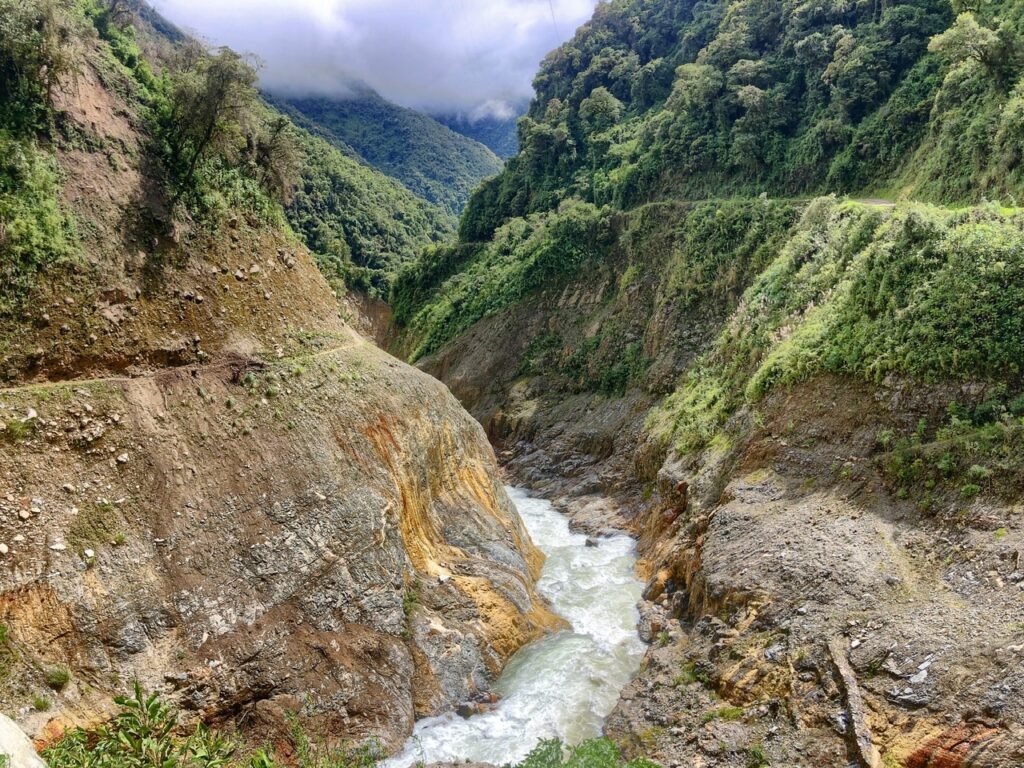
We wished them buen suerte, gulping at the raging river below, and chose to continue our leisurely stroll, not needing any more injuries.
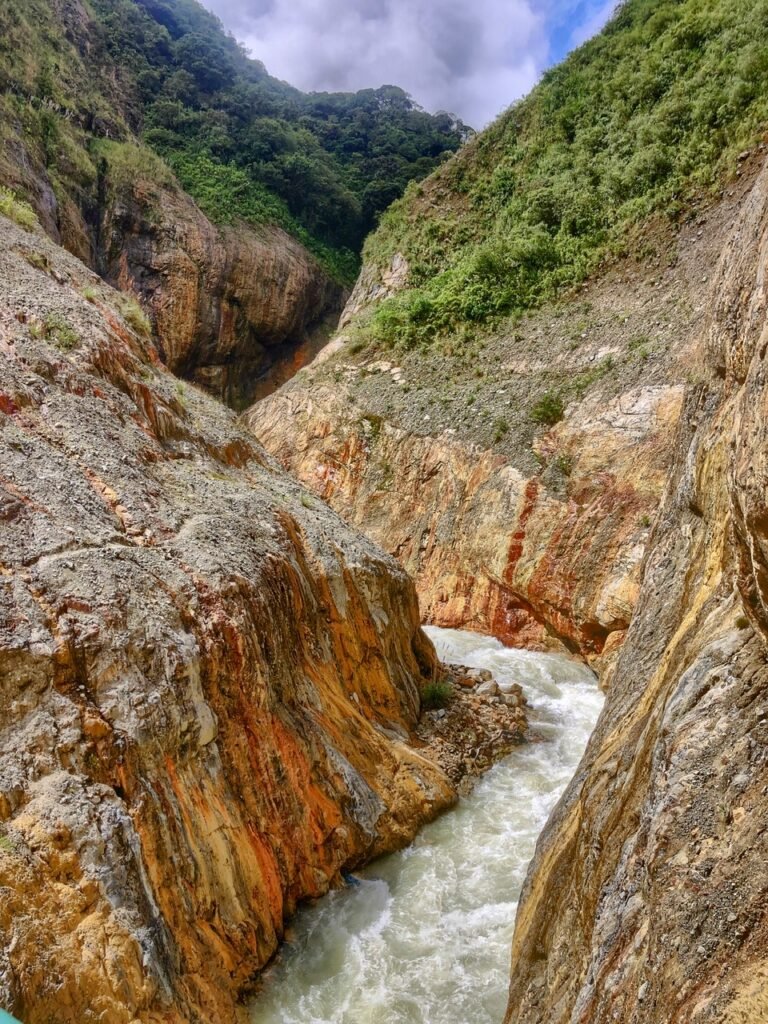
At least we were finally getting some beautiful scenery, and had to only be about a kilometer from Chicken Town!!

Next three photos <PARENTAL ADVISORY>
So…the promises of Chicken Town never arrived. We were only told something about a “rumblé” which we assumed was another name for a colectivo (Wrong.) So, we kept walking to the next village in hopes of finding the next possible way out of this mess. Instead, we began encountering miles upon miles of “no pasé” landslides, (called DE-rumbles), naturally not the the landslide word Mandy knew…”deslizamiento de tierras”)
Some of these paths were clear…
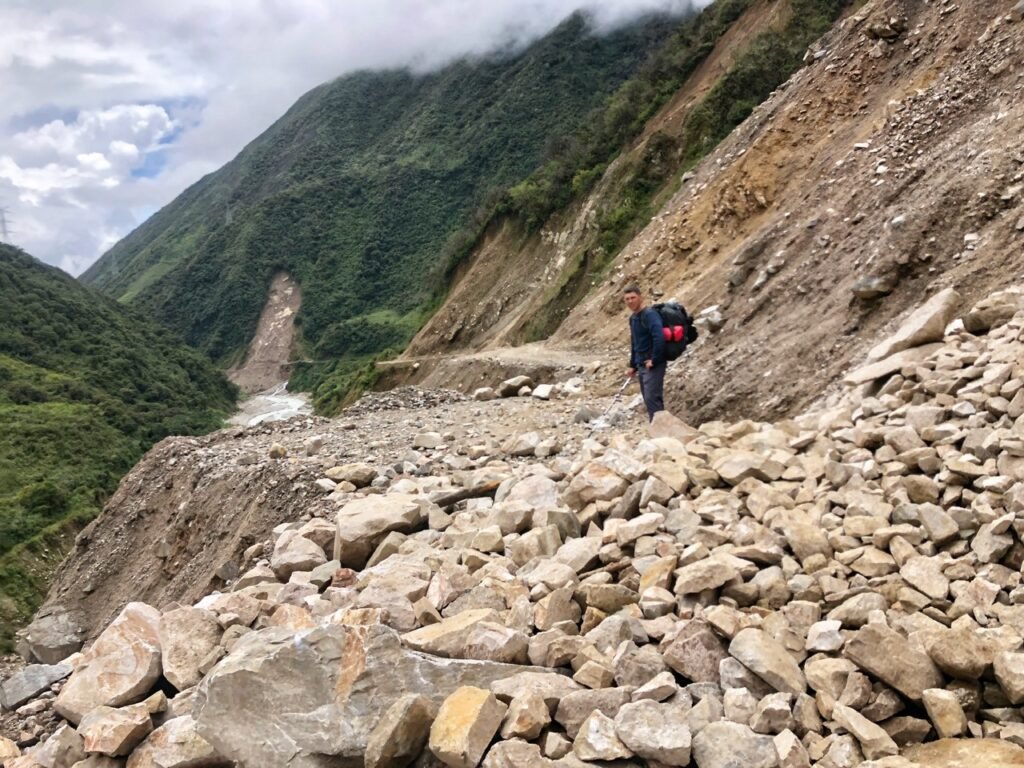
…some manageable…
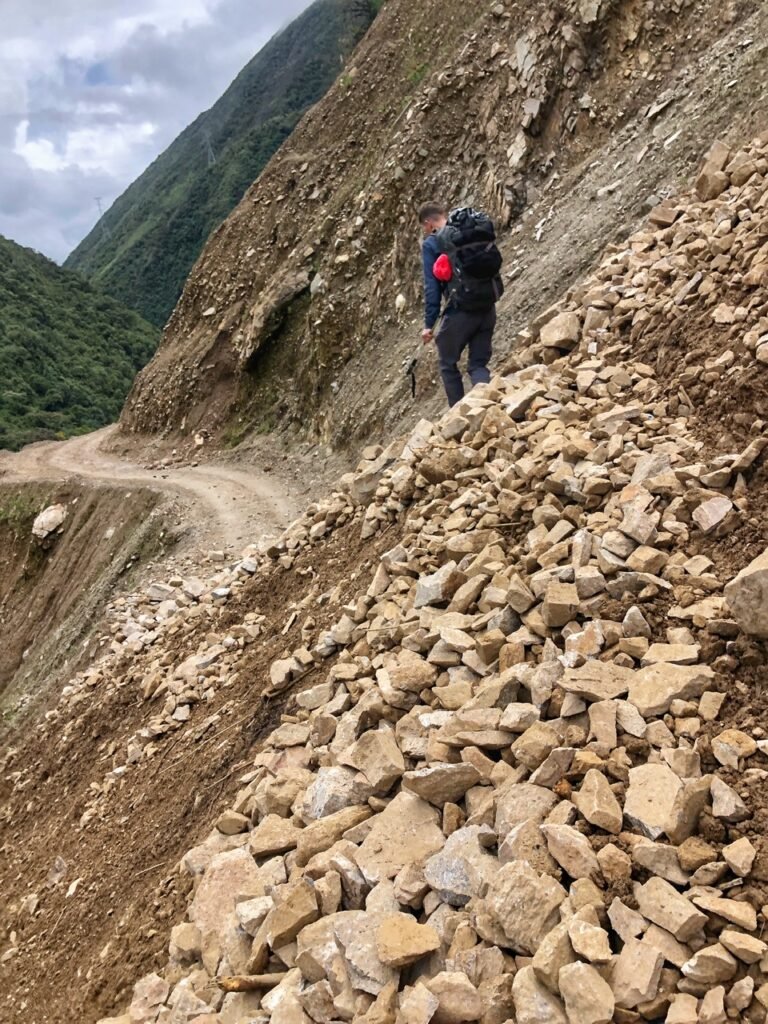
…and some treacherous enough to make our travel insurance completely nul and void should a slip drop us into the canyon. In fact, a day later, we learned that three people had died that very day due to landslides nearby. There is absolutely no reason these roads (or trails) should be open to tourists right now. Locals are already suffering enough without this extra traffic and strain on their systems. To be honest, it was quite unsettling we were even in this situation because it should have been closed, or at least warned about early in the trek. But alas, nothing was communicated. And being with a guide wouldn’t have made a difference because they were schlepping over the exact same dangerous scenarios we were, but in much larger groups.
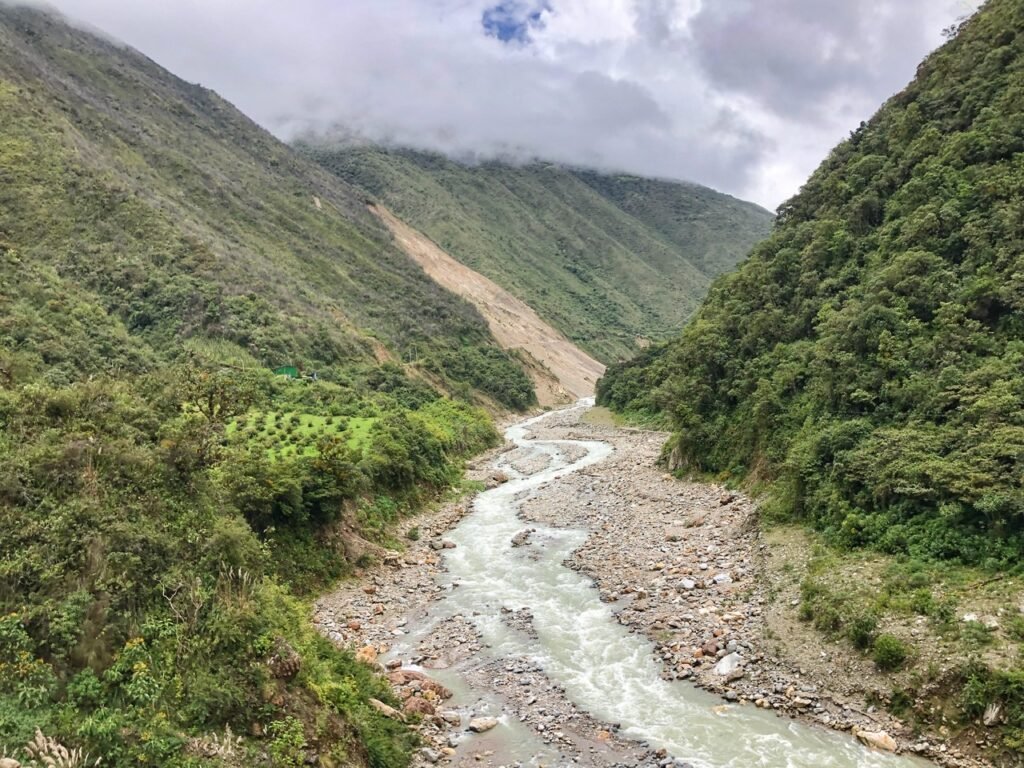
14 more kilometers somehow passed and the rains returned…
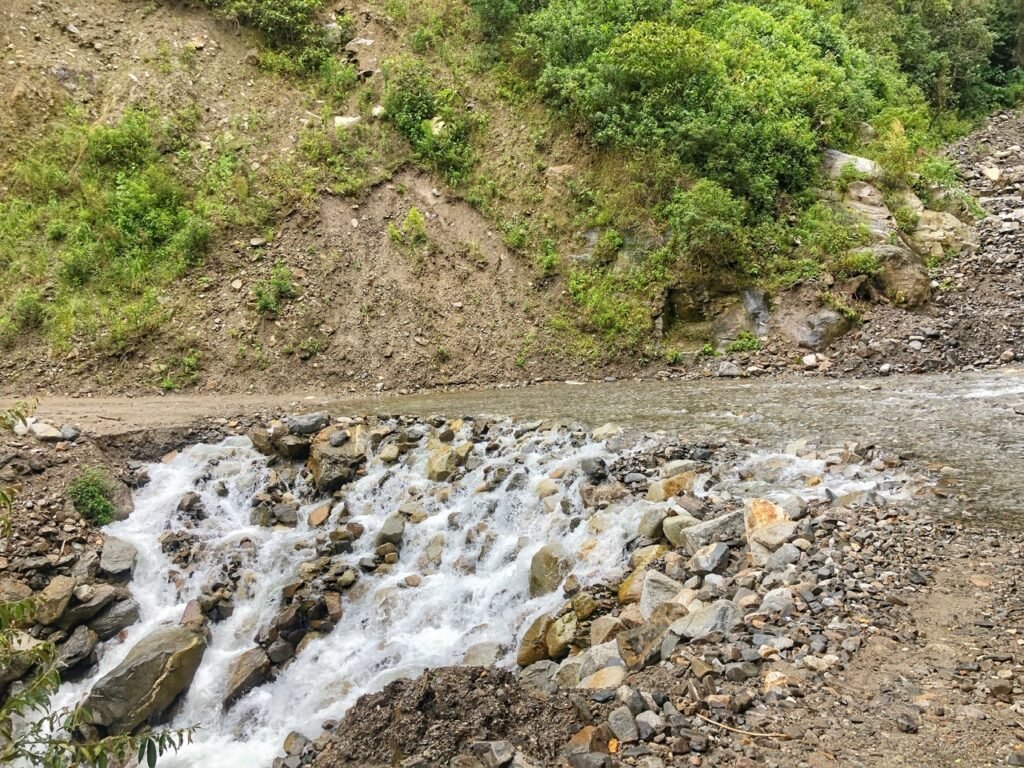
With many more landslide and water crossings…

And a little lovely relief.
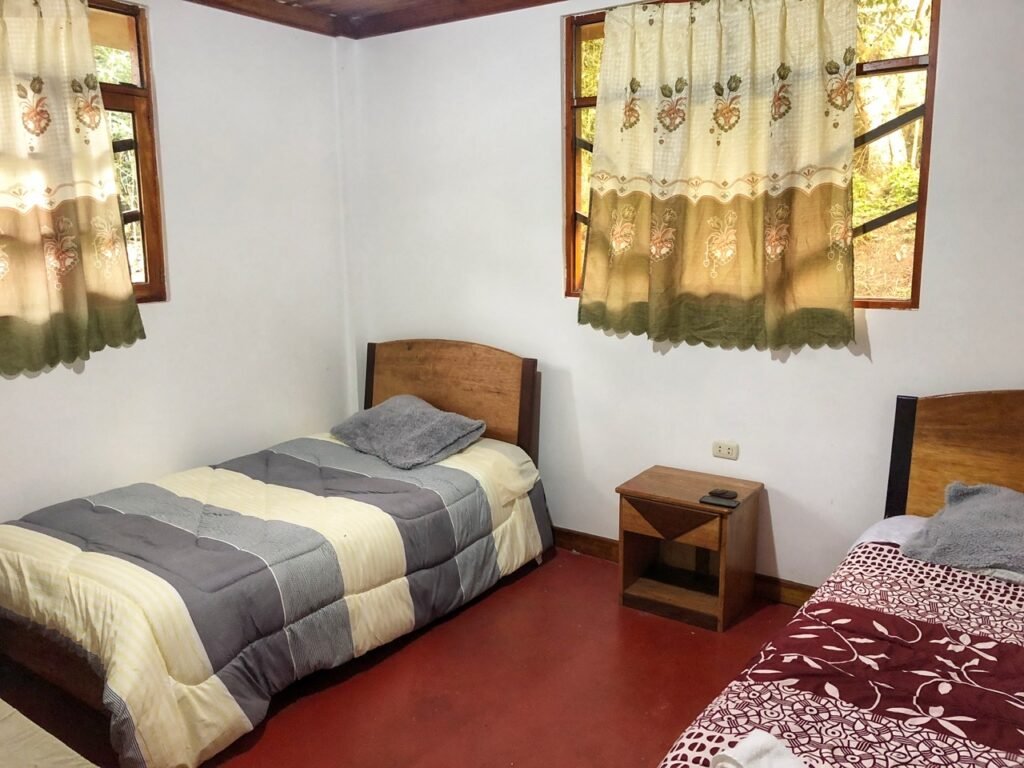
Around 4 pm, we finally toppled into the village of Sahuayaco where we met eyes with our saviors for the next day…moving colectivos across the bridge. We accepted the first place offered to us, which ended up being with a wonderful family in a room we could fully stand up in. This time, 80 sols or $20 awarded us with a HOT shower, two hot meals, and reasonably speedy internet. We couldn’t have been happier. It’s the little things on days like these. Mandy ripped her shoes off and vowed never to put the torture chambers on again. And she didn’t. (Until she had no other choice the next morning.)
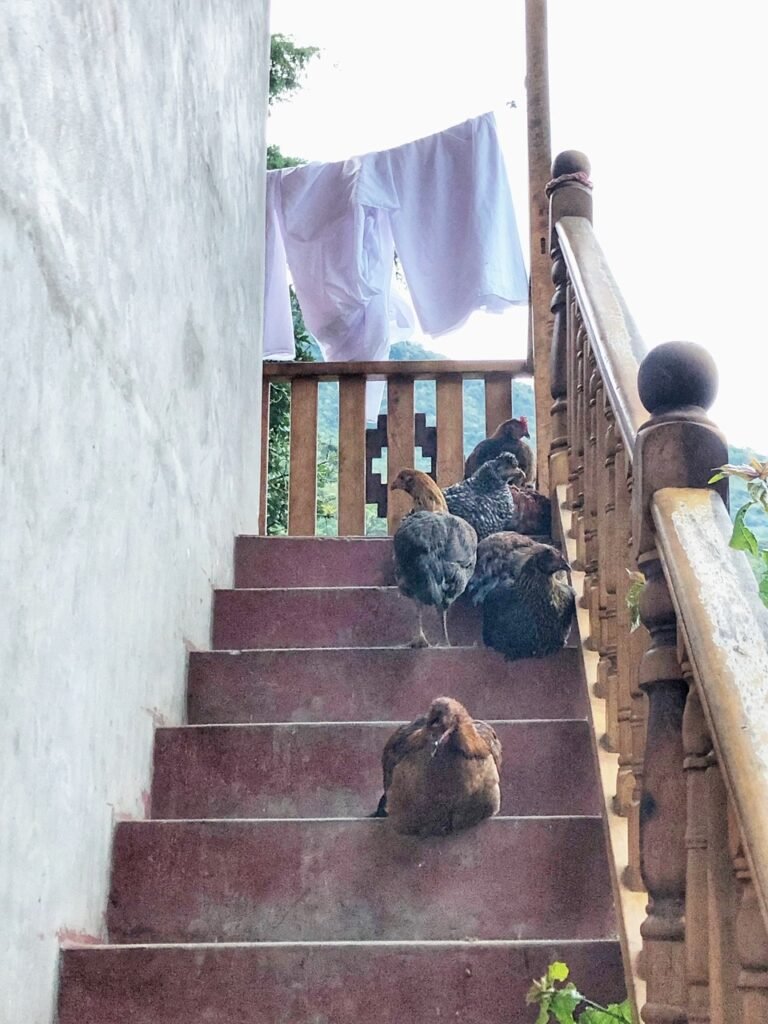
And outside our door, we heard some clucking. I guess we had found Chicken Town after all.
Day 4/Part 1: Sahuayaco (Chicken Town)>Santa Teresa
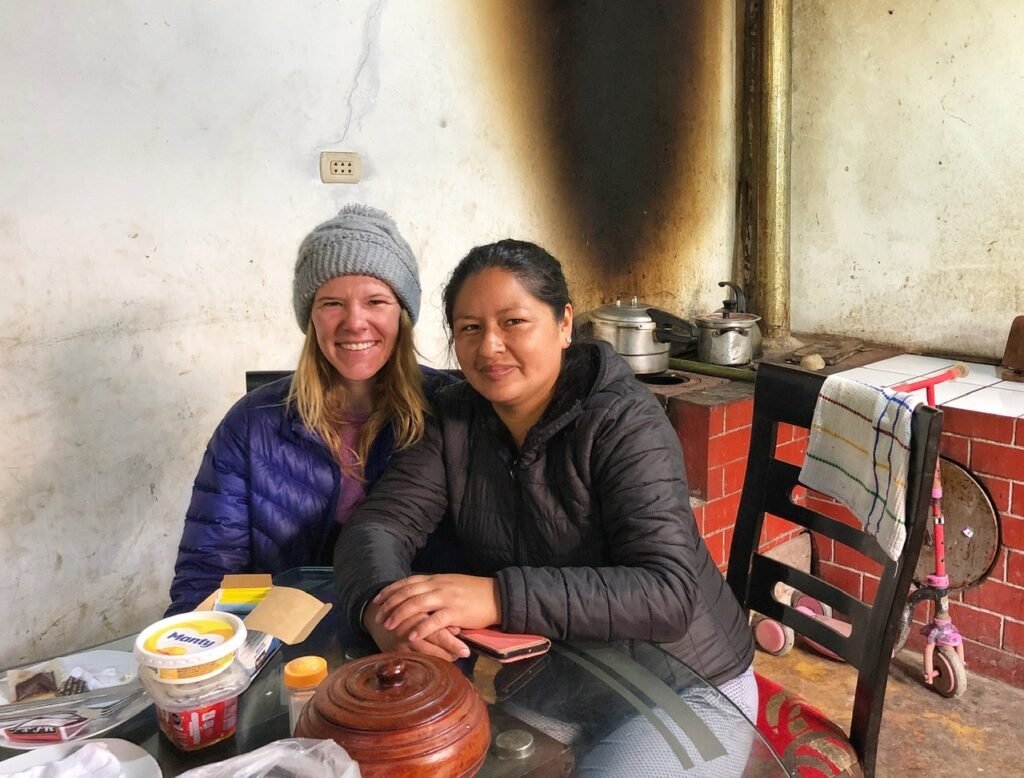
In Chicken Town, the day predictably greeted us with lots of clucking and cock-a-doodle-doing. Still, we we warm, could sit upright in bed, and confident that we would make it to Santa Teresa that morning. And although it was an adventure to get there (could we expect any less?), we indeed made it back to the Land of the Motor Vehicle Connections!
At breakfast with our sweet and social hostess, Laura. She invited us eat inside her personal kitchen, also inundated with (live) chickens, which she shooed away while serving us with piles of eggs, fruit, breads and jams.
She and her family had grown up in the village of Sahuayaco. Her husband worked in “systems engineering” and her kids were on summer vacation from school, but excited to go back on March 28 because it would be their first time in real school since COVID. Oh, and at our feet was a dog named Bob. It’s the second Bob the dog we had met in Latin America ?
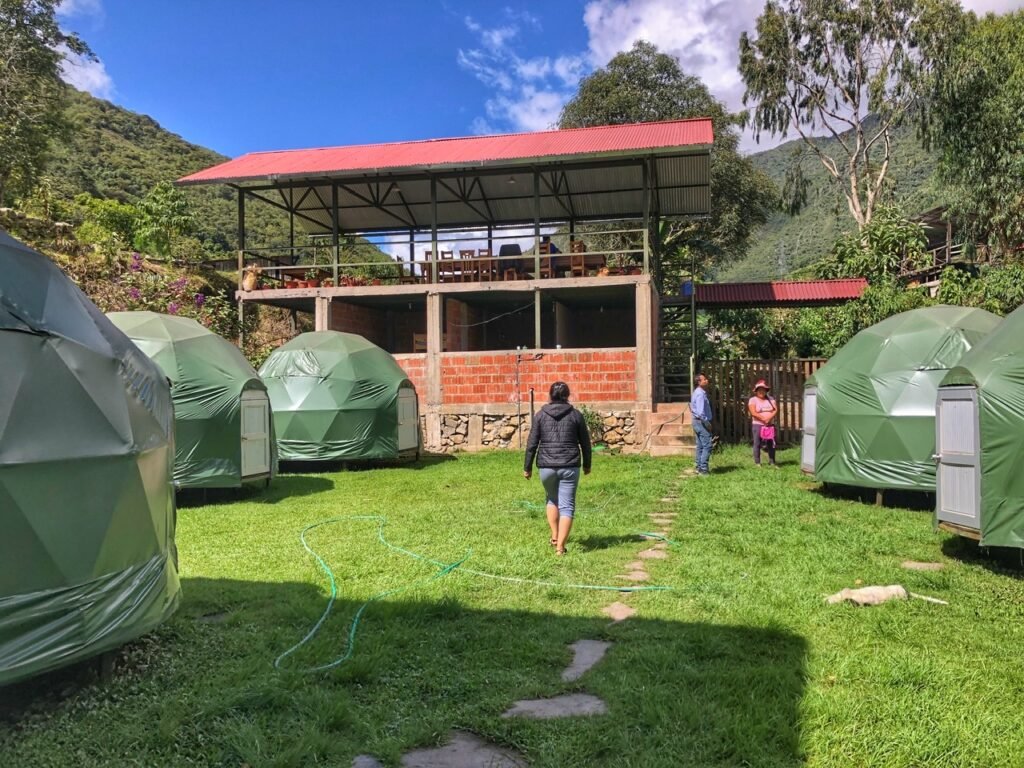
Laura’s place, called Hospedaje Corbacho, also offered eco domes which were not available during the crap season months. Like every local we met on the trail, we were told the months of December, January, February and March were really not good months for trekking. Gracias por el tip. ?

To get to the colectivos, Laura assured us all we needed to do was go to the end of the road, cross the bridge and there they would be waiting. And we saw them!!! Hooray!
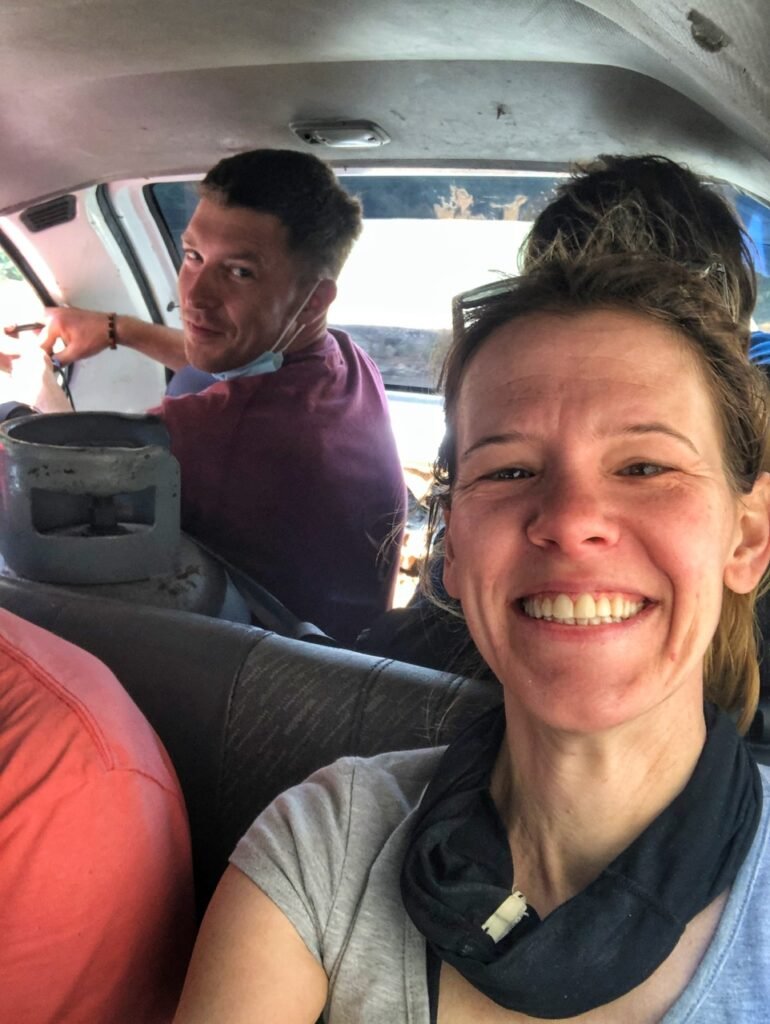
But alas, when we arrived at the colectivos, they were sitting untouched like a sack of rotten potatoes. No drivers or other passengers were to be found. As we began asking around, we were told to “espera….”…wait…so we plopped down in our newfound t-shirts and basked in the flooding sun. It was a beautiful day, of course, now that we didn’t have to walk anywhere. So we waited…and waited…and waited for a colectivo to appear. One did not appear, but a group of locals asked if we wanted a ride to Santa Teresa. So, for the bargain price of 8 sols each ($2), Greg got stuffed into the trunk of a car with another backpacker and a gas canister….
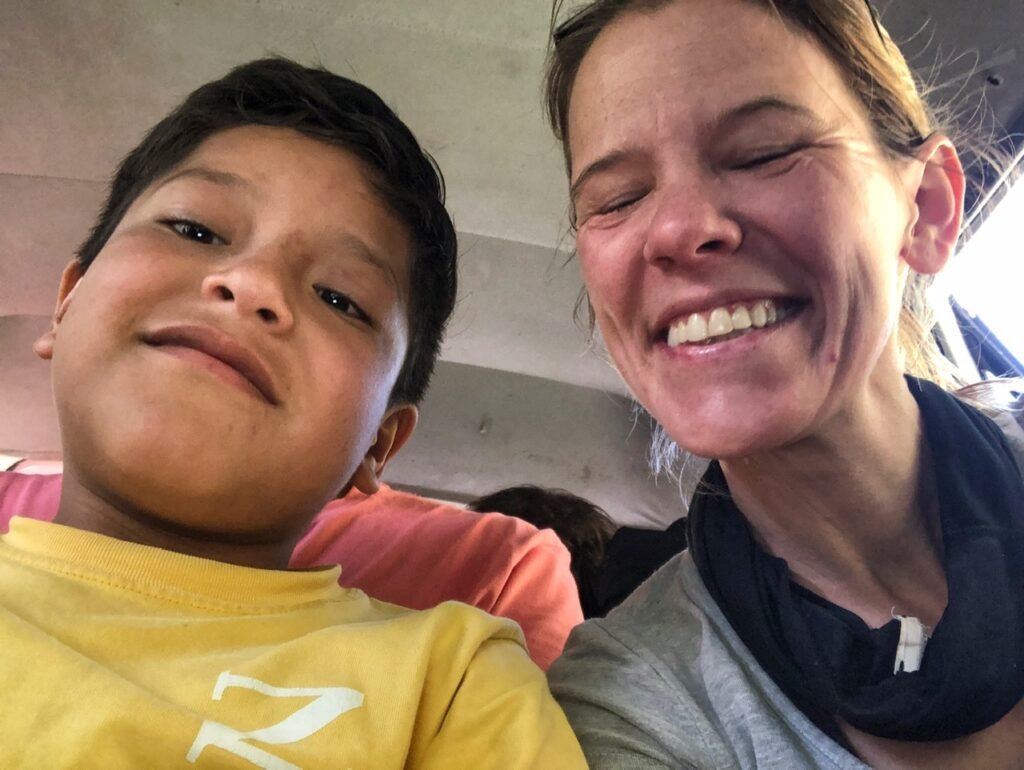
…while Mandy sat like a princess with the locals upfront. Poor kid (Julio, who had 8 years) was probably like, “who the hell is this downtrodden and tired-looking gringa lady who can’t even open her eyes for a selfie!?”
And of course, as we began to move, parts of this road were just as perilous as the roads barely grasping onto cliffs we had walked on the day before. Not to mention the rigid bumps and winding whips, all with a gas canister and an Argentinian dude digging in our back (for one of us.)
We also had to stop, and completely reverse, about 50 feet at one point because a gigantic dump truck was coming in the opposite direction. For this maneuver, the driver (who looked like a teenager) wisely tossed Greg and the Argentinian out of the car on the side of the “road” so he could use his mirrors. When the teenager closed them back in the trunk, he narrowly missed what was left of Greg’s toes by a few centimeters.
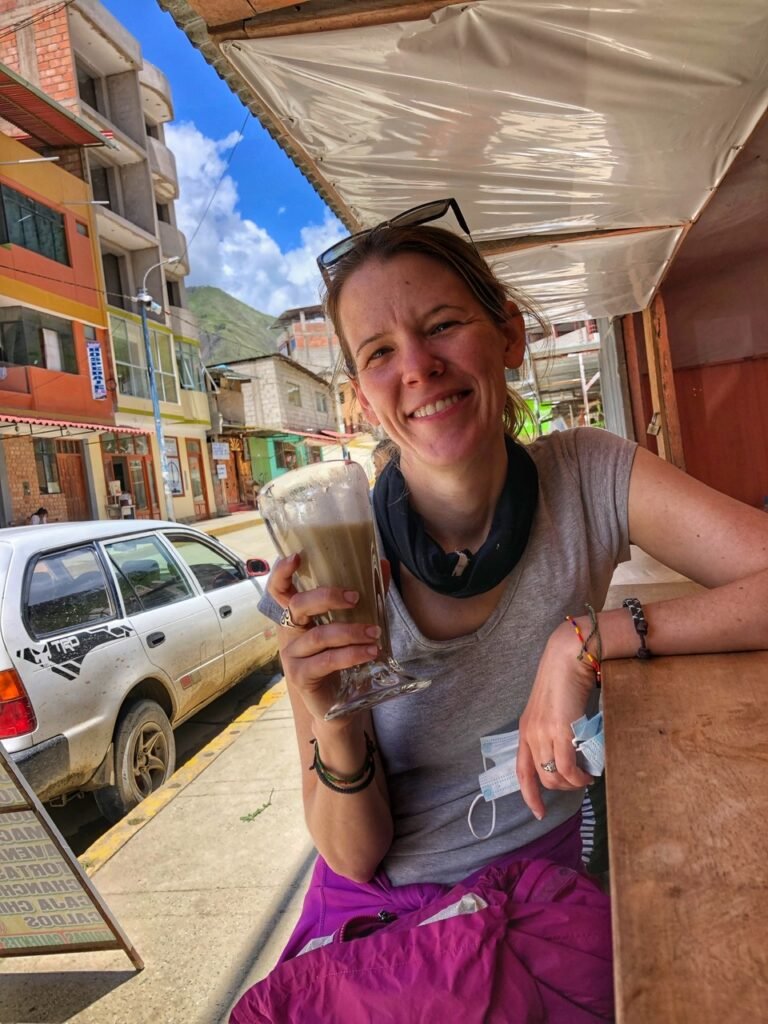
We mercifully arrived to Santa Teresa 45-minutes later and immediately downed giant glasses of banana juice to pump some potassium through our tired muscles. This also allowed Greg the opportunity to vent and decompress about being sardined in the near-death-mobile.
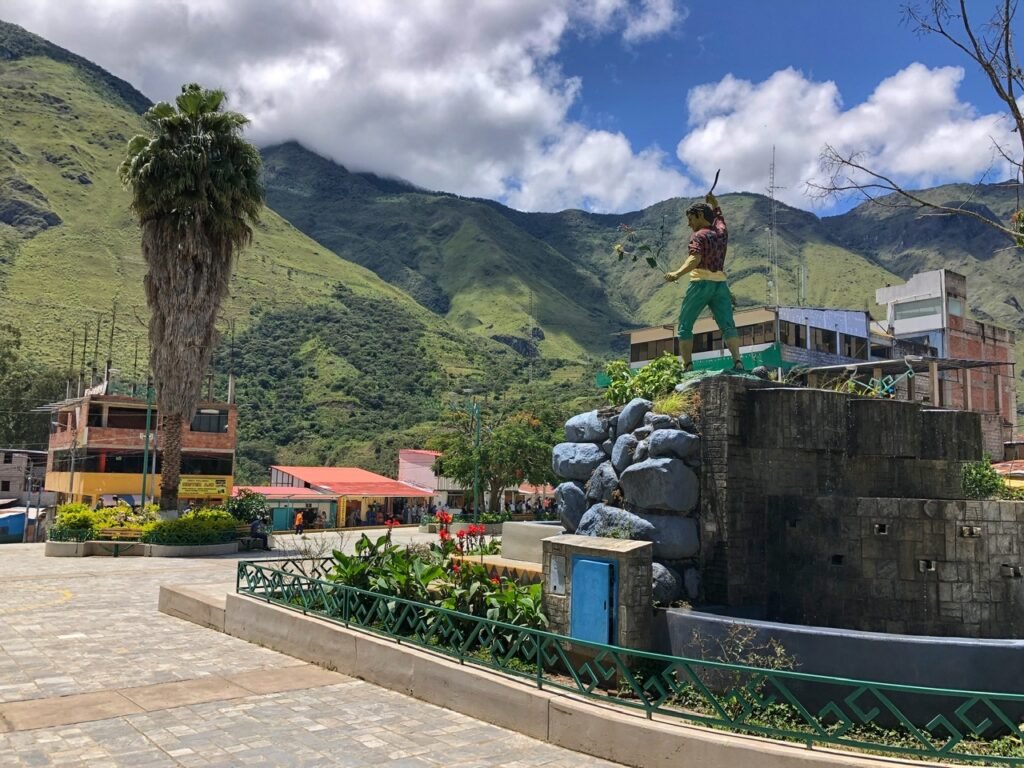
The town of Santa Teresa was bright and cheery. What a welcome sight!
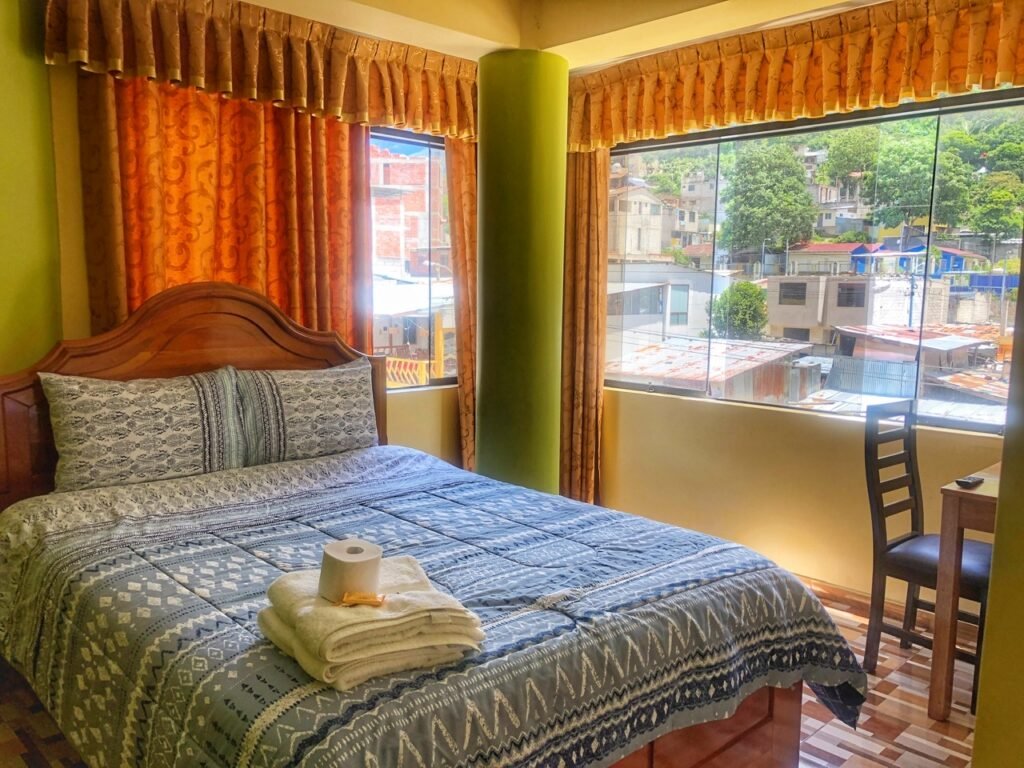
We settled in a hotel called Montevilla, which was recommended by Laura (chicken lady.) Like the town, it was bright and cheery and cost 60 soles or $16.

And it had a lovely view from our window which was streaming with sun. We took advantage of the warmth by washing our socks and undies and laying them out to dry on the hotel floor.
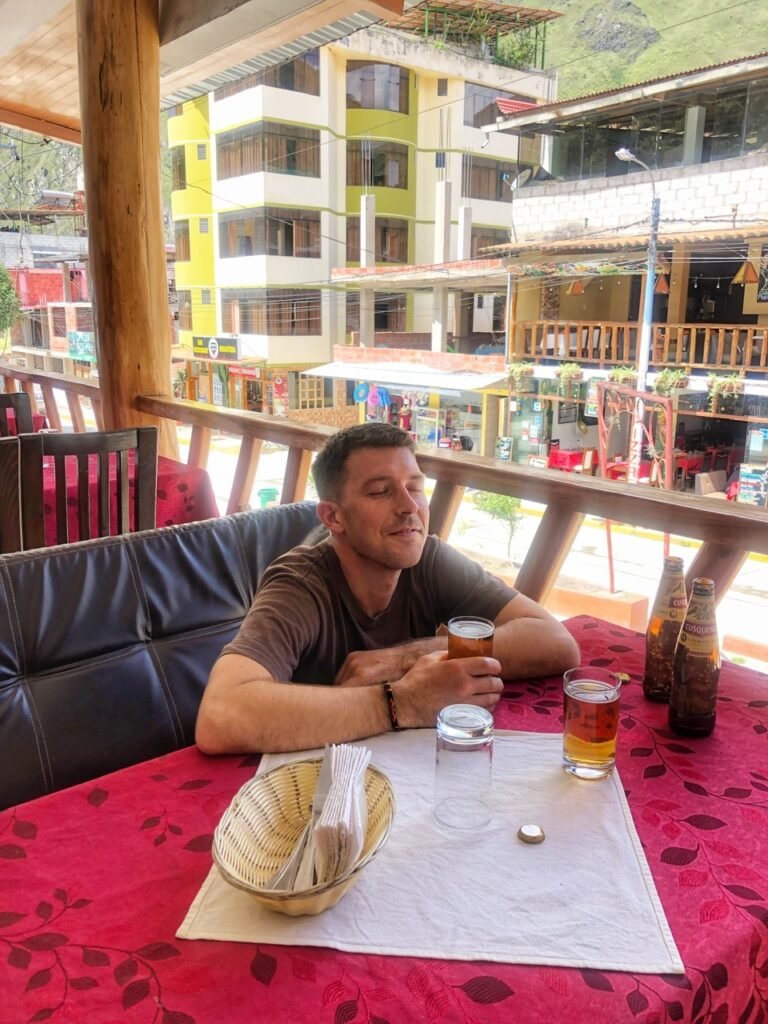
The next order of business was a celebratory beer for having survived the last 3 days.
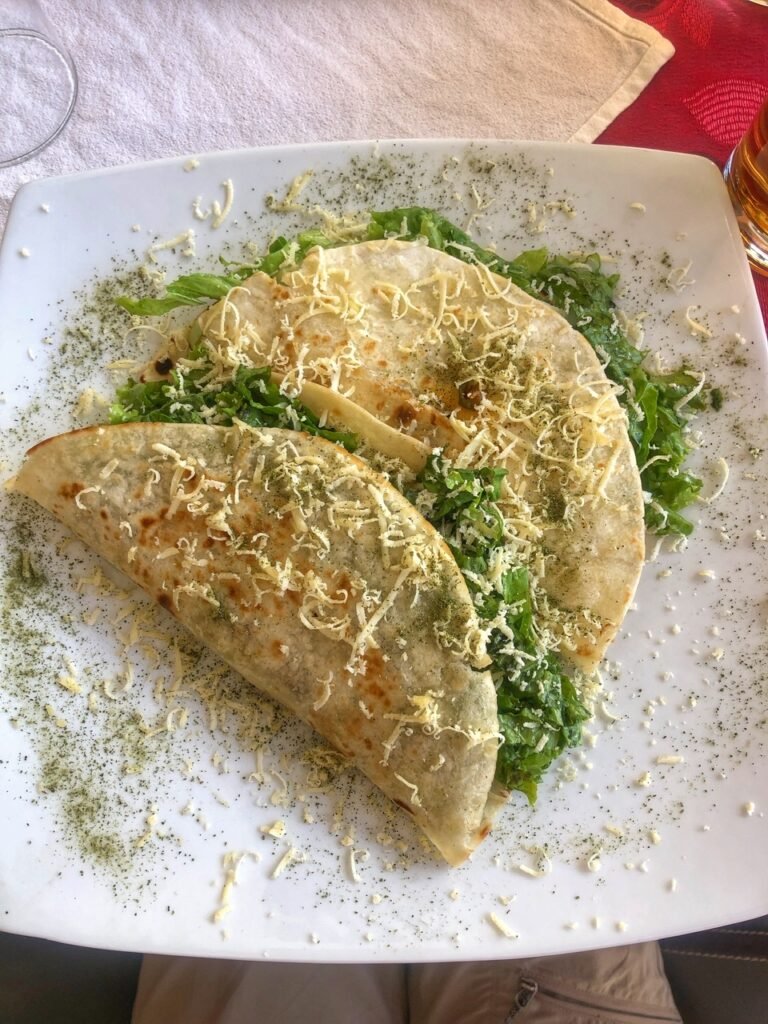
Along with some ridiculously overpriced American-looking tacos. But every sol was worth it…
Day 4/Part 2: A Blissful Reward: Colcamayo Hot Springs
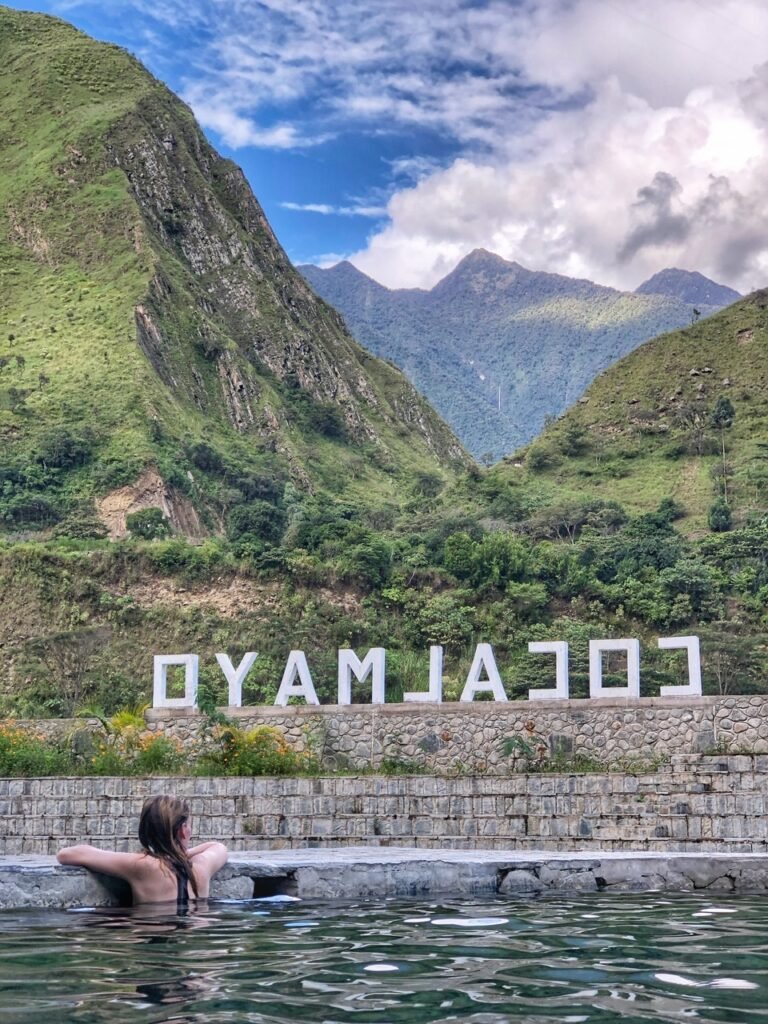
It was time to give some love to our aching bodies. So, after a wannabe taco lunch and a well deserved siesta, from Santa Teresa, we jumped in a tuk tuk, which are called “Torritos” or “Little Bulls” here. Fifteen minutes down a very lumpy path next to a raging river, we landed at the hot springs of Colcamayo. These hot springs are renowned for being off the beaten path, unlike the ones in Aguas Calientes. They are also renowned for actually having hot water (39 degrees Celsius/102 F) in an absolutely phenomenal setting. Score!
It cost 10 soles or $2.50 to enter this paradise and you get 1.5 hours of time. The natural surroundings, especially with the distant waterfall cascading down the mountain, felt more like Hawaii than Peru.
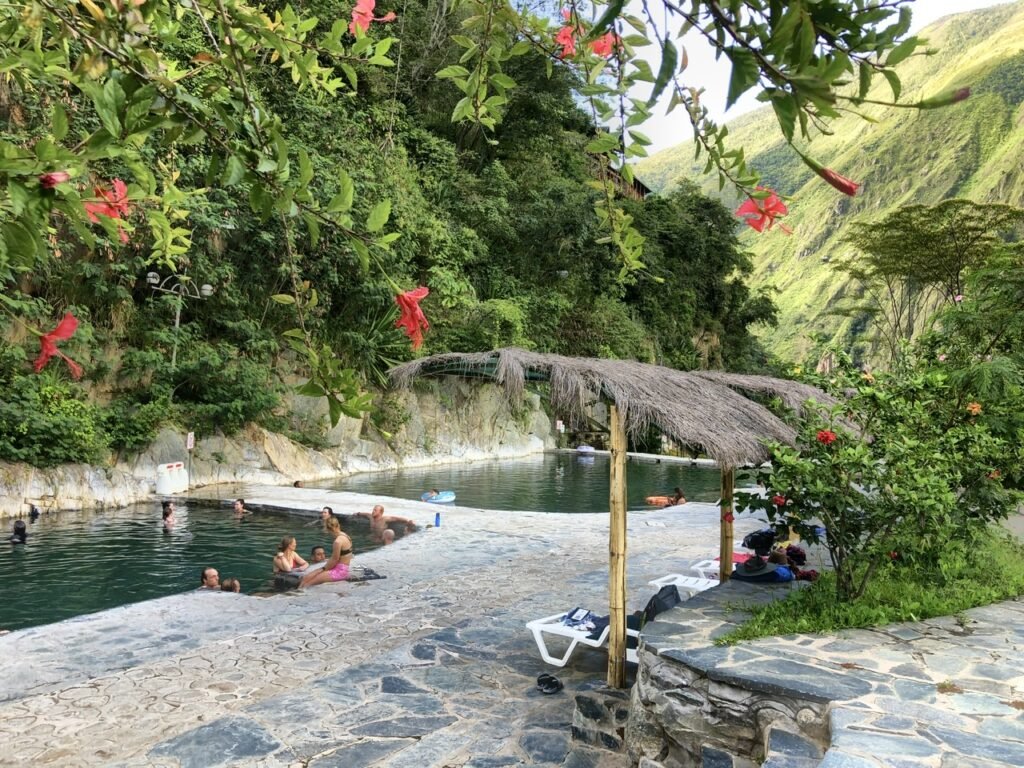
There were three pools each with varying degrees of hot water.
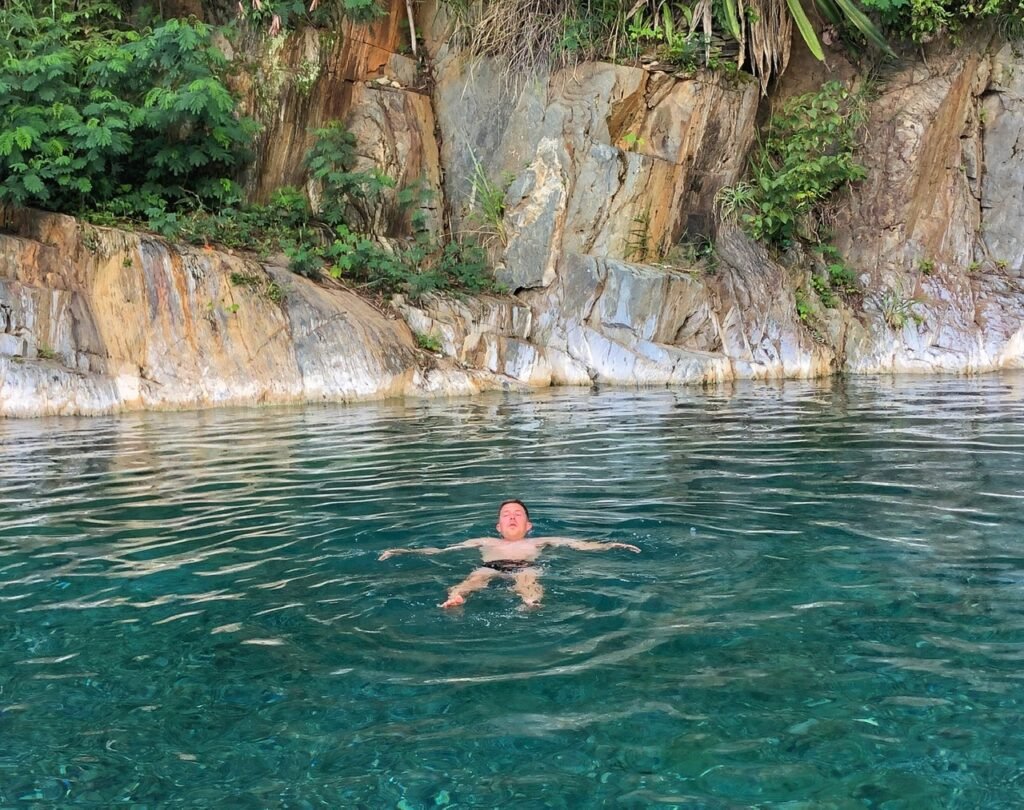
Greg having a well earned soak.
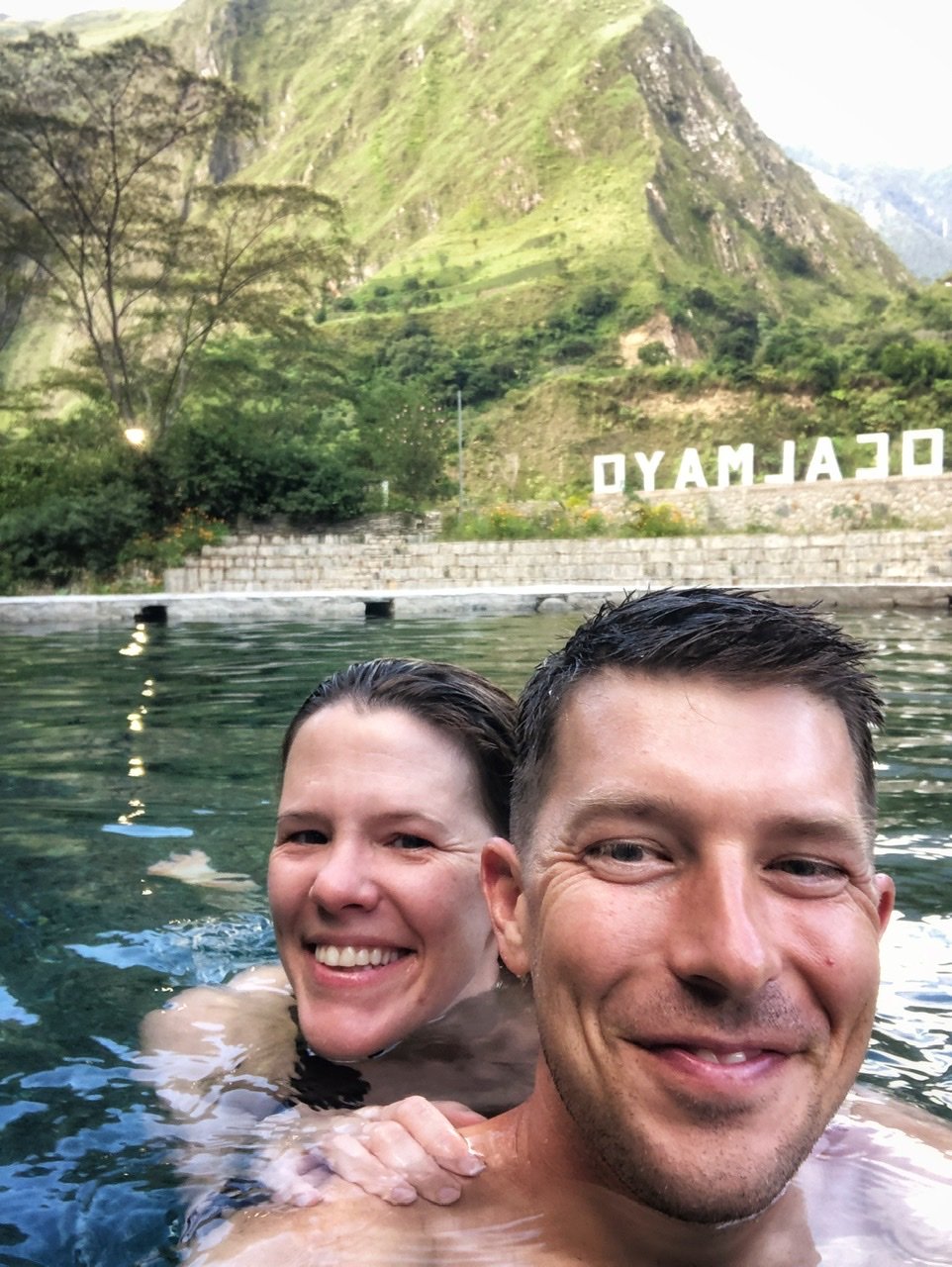
A little bit happier now!

The edge of the pools features a hot springs waterfalls pouring from the pools. Unfortunately, these were also coming from the coolest pool available!
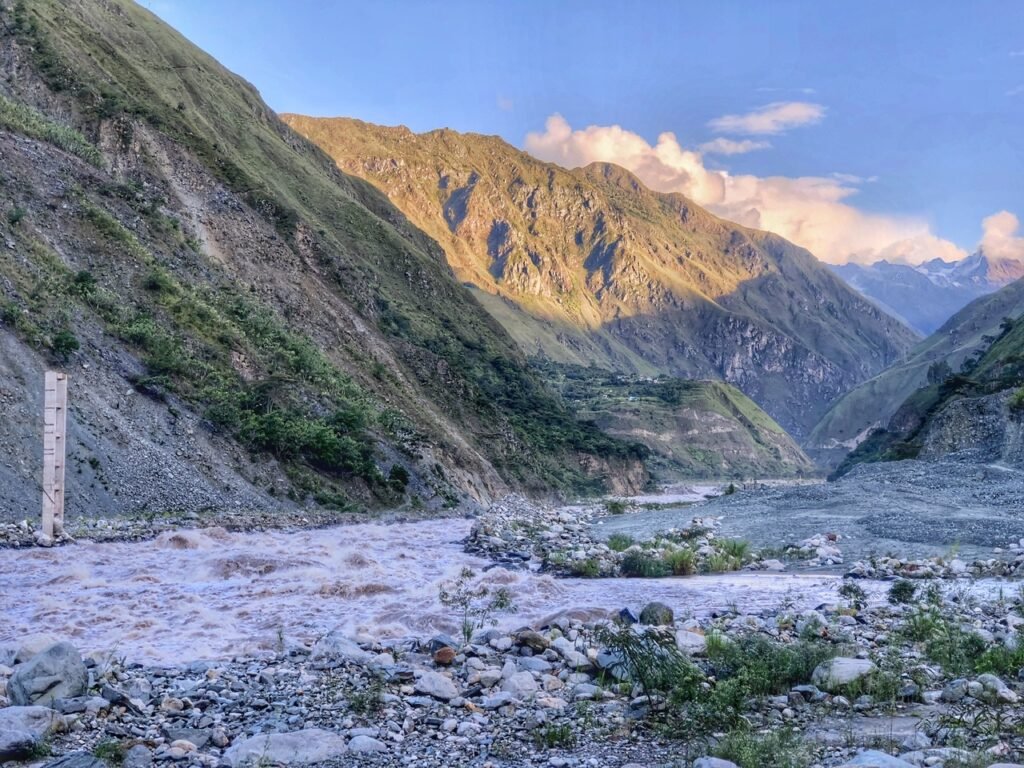
The valley that surrounds the hot springs.

On our way out, we noticed an actual sign that said…guess what? The bridge from Santa Teresa to Hidroeléctrica, where we needed to go the following day to make our final jaunt to Aguas Calientes, was…. “No pase” due to construction. Naturally. It was only open from 9-9:30 and 12-1, slightly better than our experience in Mollepata. Thus, we knew we had a very narrow window to make it through, and that more fun was inevitably in store for Day 5.

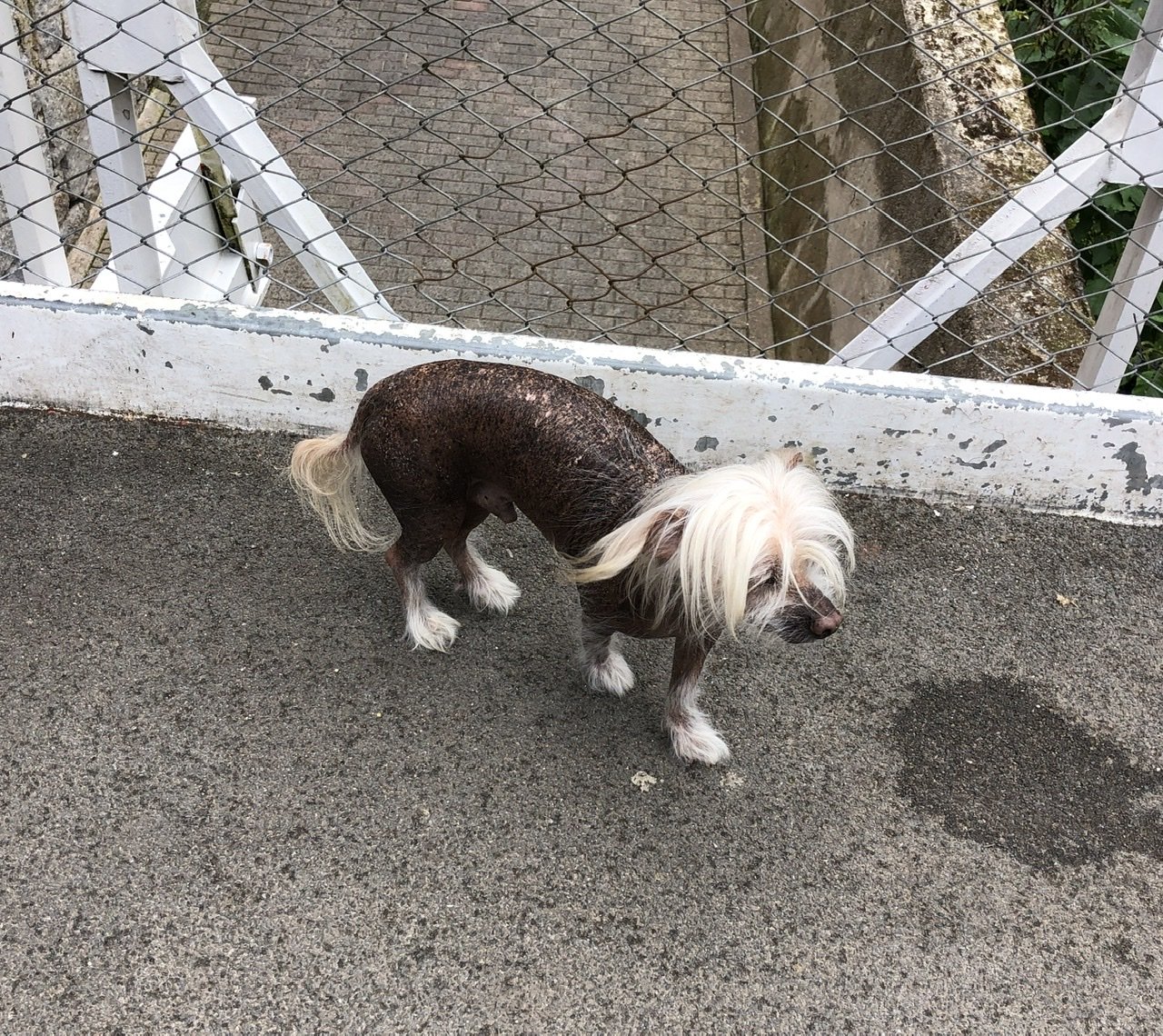
But before that, we had to make some commentary on the Peruvian Hairless Dog. This breed, which are extremely rare and go for $2,000-$4,000 in the States, seem to be frolicking everywhere throughout its native country. Should we have dropped one in our backpacks? This dog is actually part of Peru’s cultural heritage and come in three sizes and varieties. While not the cutest of the canines, they are particularly popular because their bodies radiate heat. Since they seemingly don’t have furnaces here, many in Peru use the dogs as living hot water bottles for warmth at night or for pain management. They are intelligent, affectionate with family, but wary of strangers and very protective of women and children in the family. (Wikipedia)
Yep. That dog is worth $4000?

Other bizarre things in Peru: red bananas and green oranges. Red bananas are known for sometimes being very girthy and very sweet. They’re particularly rich in potassium, vitamin C, and vitamin B6 and contain a fair amount of fiber.
Day 5: The Final Slog: Santa Teresa>Hidroelectrica>Aguas Calientes
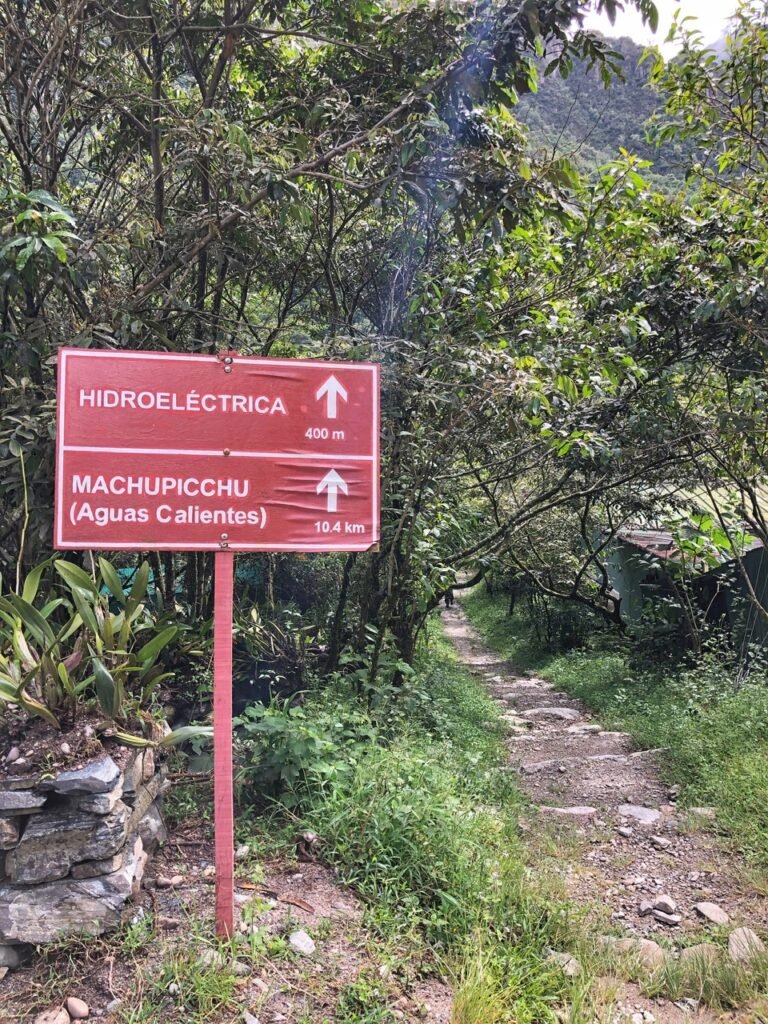
When we arrived to the hotel, we showed our front desk agent the concerning road closure sign we had seen at the hot springs. He assured us there were many colectivos leaving a little before 9 am from the plaza, which would ensure we could make it through the roadwork before it closed again at 9:30. Well…this was fake news. There were no colectivos. After nervously waiting and asking around 10 minutes, we asked a police officer and he directed us to the market a few blocks away where a number of colectivos were waiting…again with no drivers or passengers. The clock was ticking so we had no choice but to hire a private driver to take us to Hidroeléctrica, about 30 minutes away for 30 soles or $8. We swept through right before the bridge closed. Whew!!
From Hidroeléctrica, there are two ways to get into Aguas Calientes, the famed tourist town at the base of Machu Picchu. More walking…for a mostly flat 10.4 km along the train tracks, or taking the train…a exploitively expensive 40-minute ride for $30/ticket.
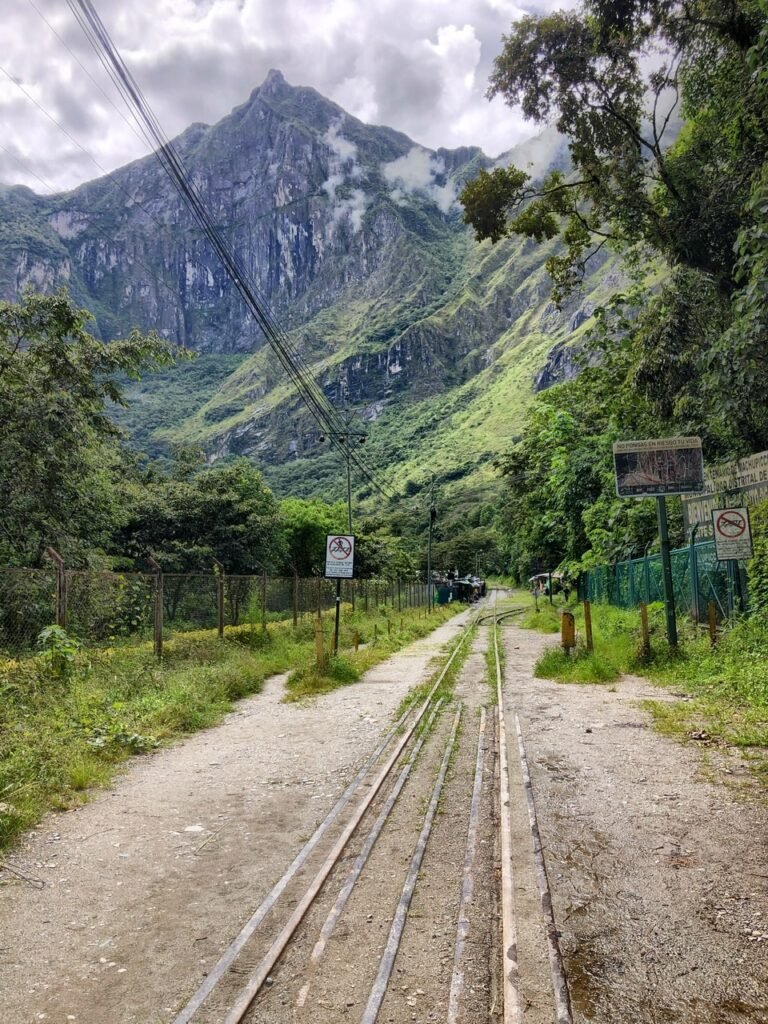
Despite the healing waters of the hot springs, Mandy’s foot was unquestionably still causing serious discomfort, but the train was not running. Thus, the difficult choice was made for us.
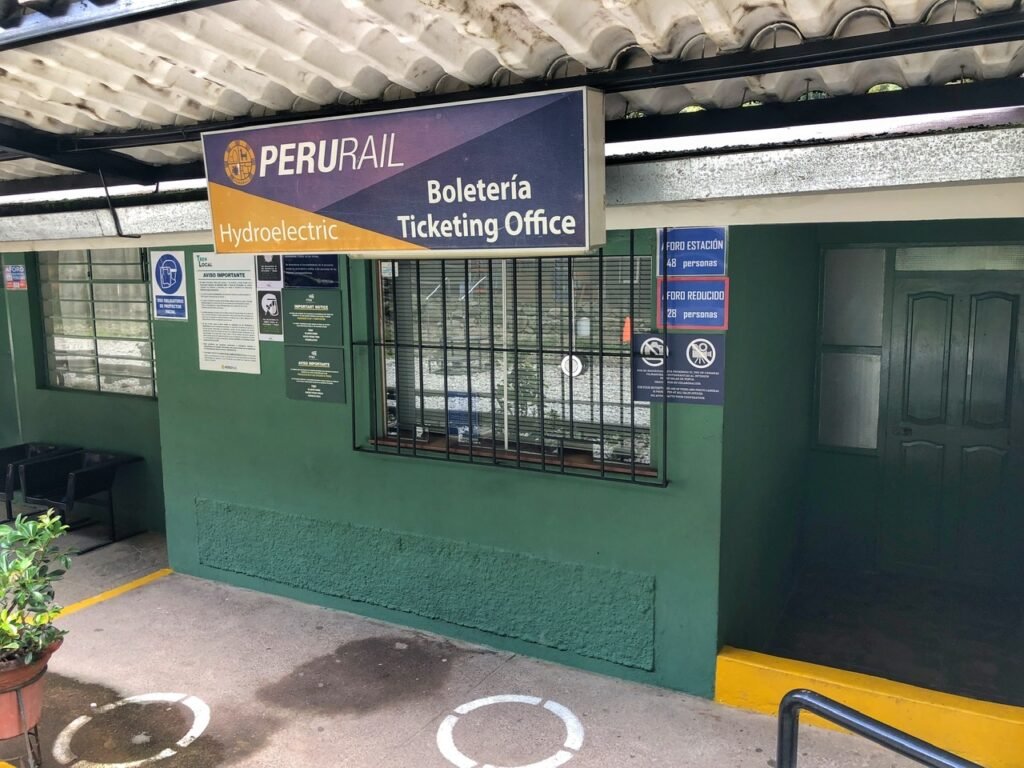
The closed ticket office at the train station.
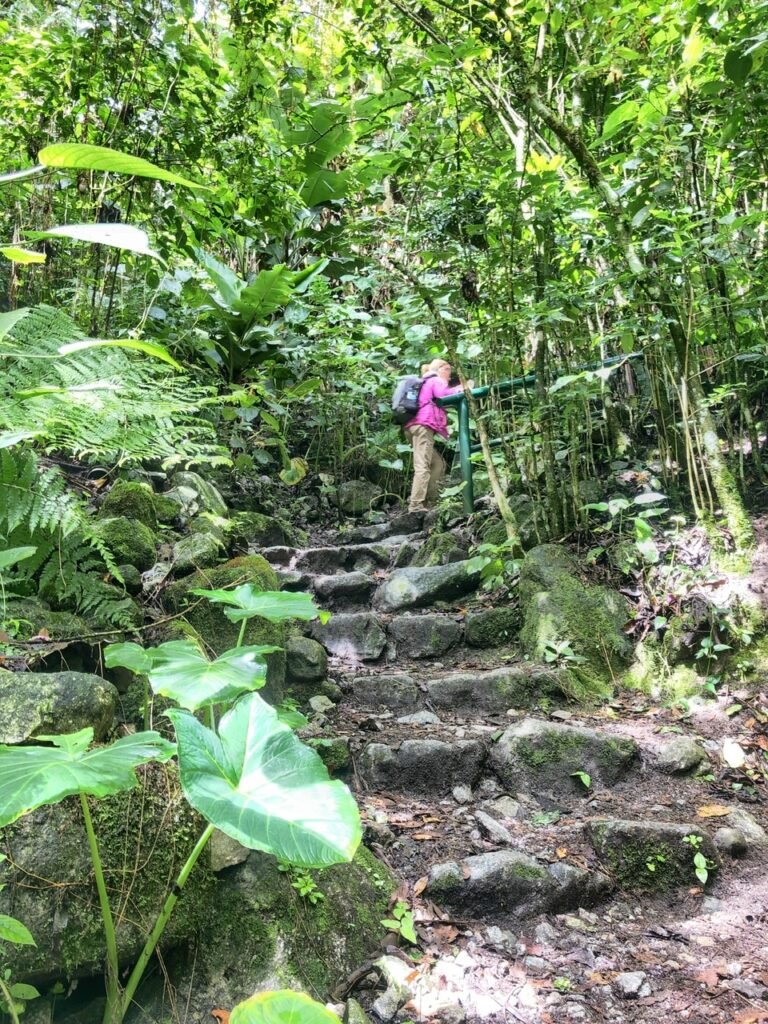
This was fortunately the only bit of elevation gain on this part of the trek.
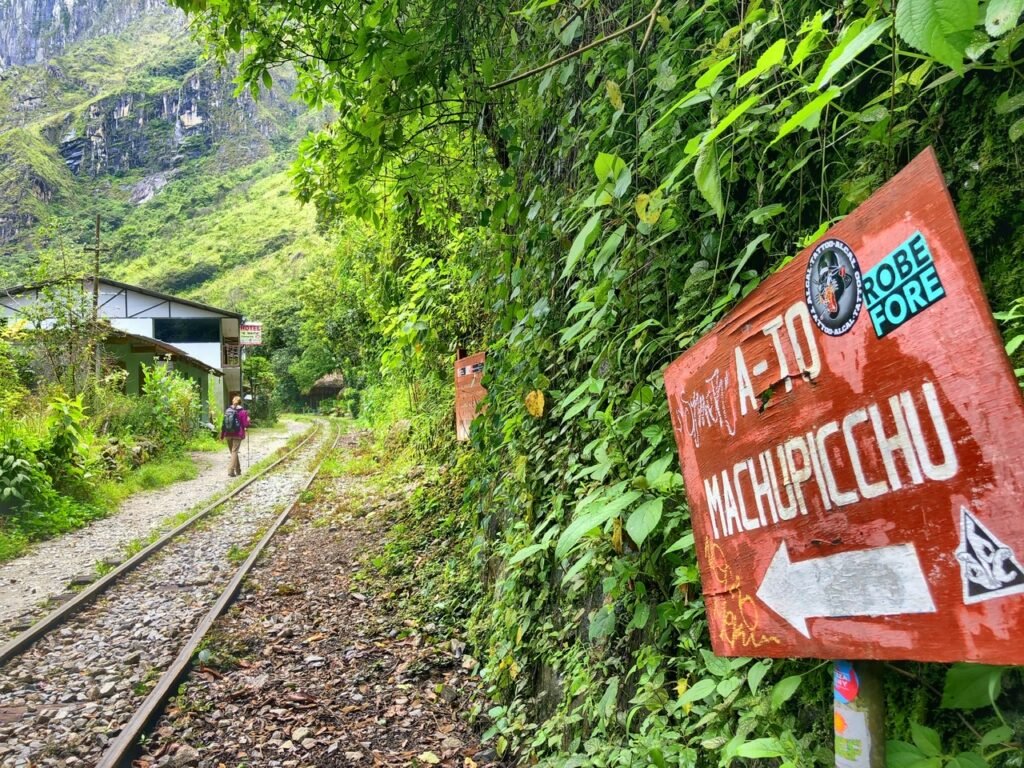
And the following three hours was flat sauntering from that point forward. But that didn’t mean that stepping on stones was easy for a girl with a bunionito! ? But…it was so beautiful! The weather and the valley…we can see why the Salkantay Trek is so beloved.
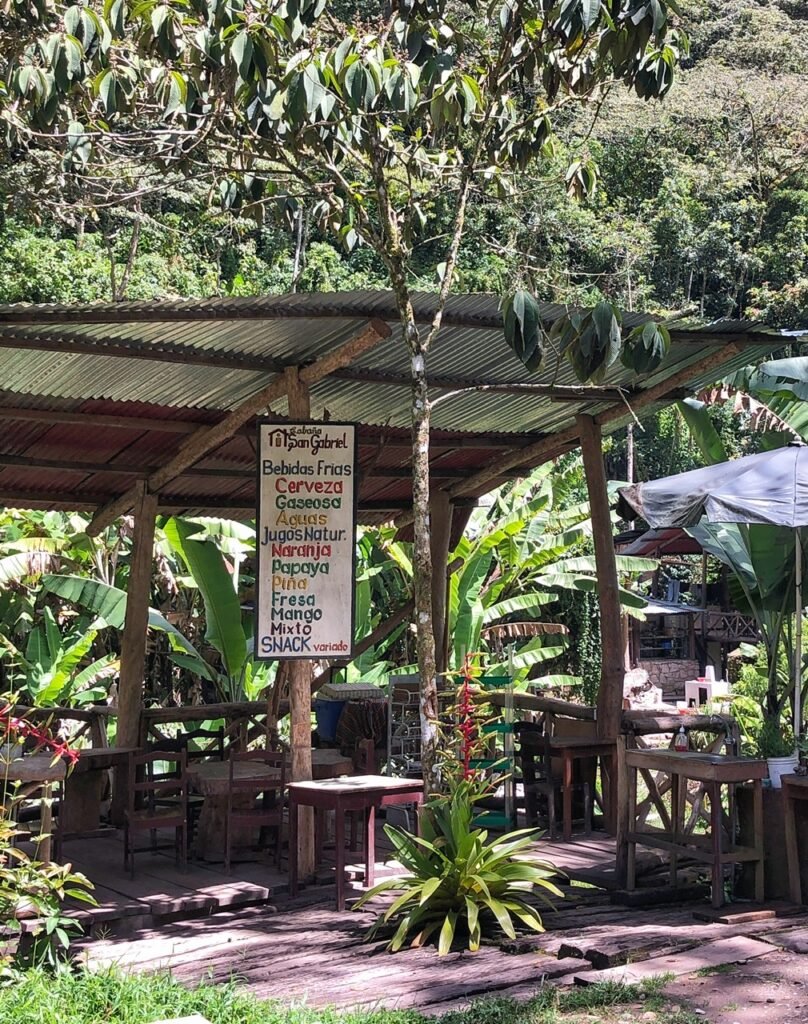
Along the route, we saw many cute cafes where you could grab and juice or coffee. There were also a lot of fellow backpackers walking from Aguas Calientes to Hidroeléctrica. The reason? They were heading to Santa Teresa (yep, that’s where we we came FROM) so they could take a 10-hour bus ride back to Cusco. This is the ONLY way to avoid the astronomical fares of having to take the train back to Cusco from Aguas Calientes. Peru has definitely capitalized on their most prominent attraction and the only way in or out of the town are by train or foot. Our comments on that will come soon enough…
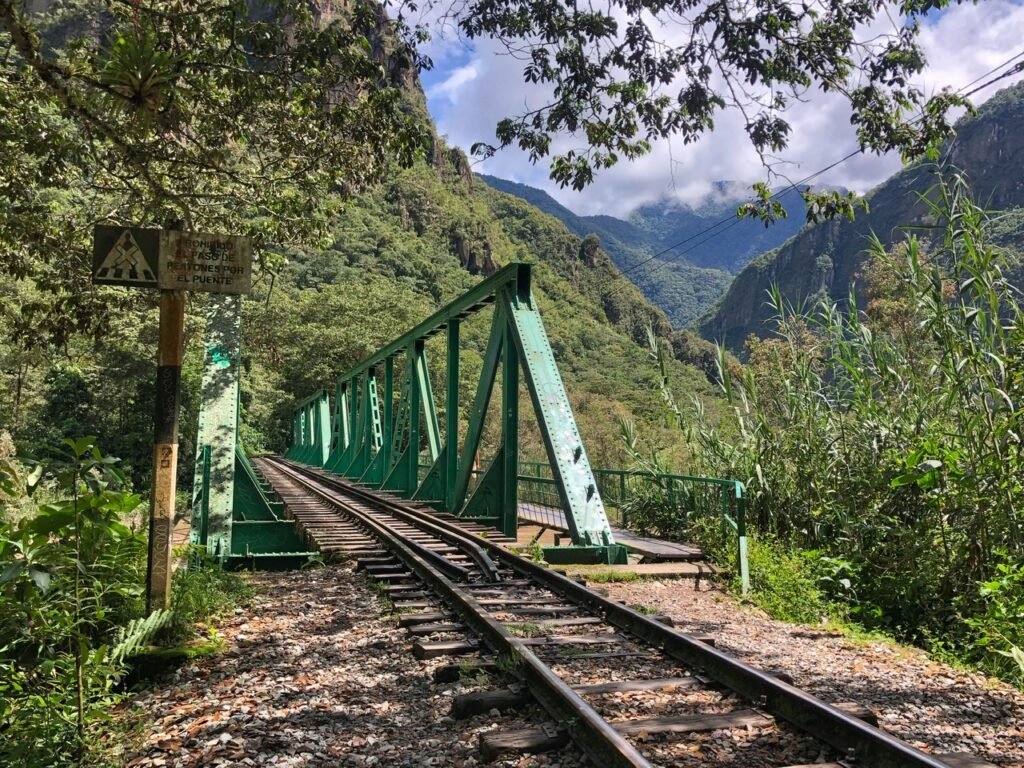
One of many bridges over the violent river.
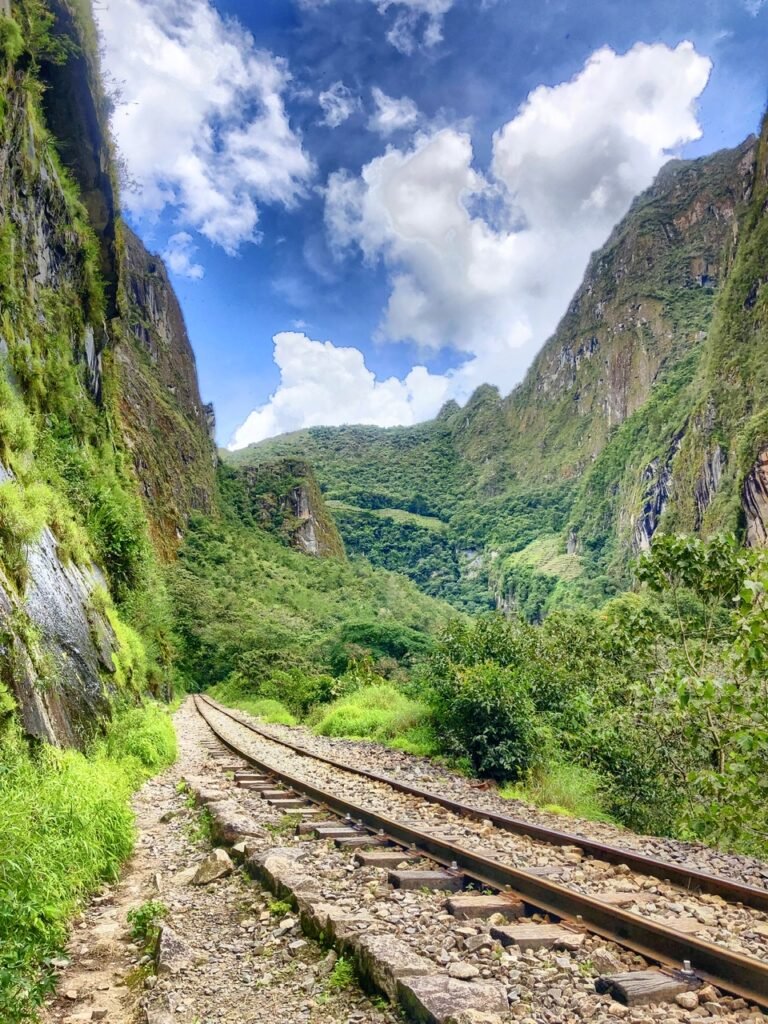
Getting closer, we began to see a land that resembled those iconic photos of Machu Picchu that we all know and lust after.

Greeted to the town of Aguas Calientes by the raging river…and you guessed it…more liquid sunshine.
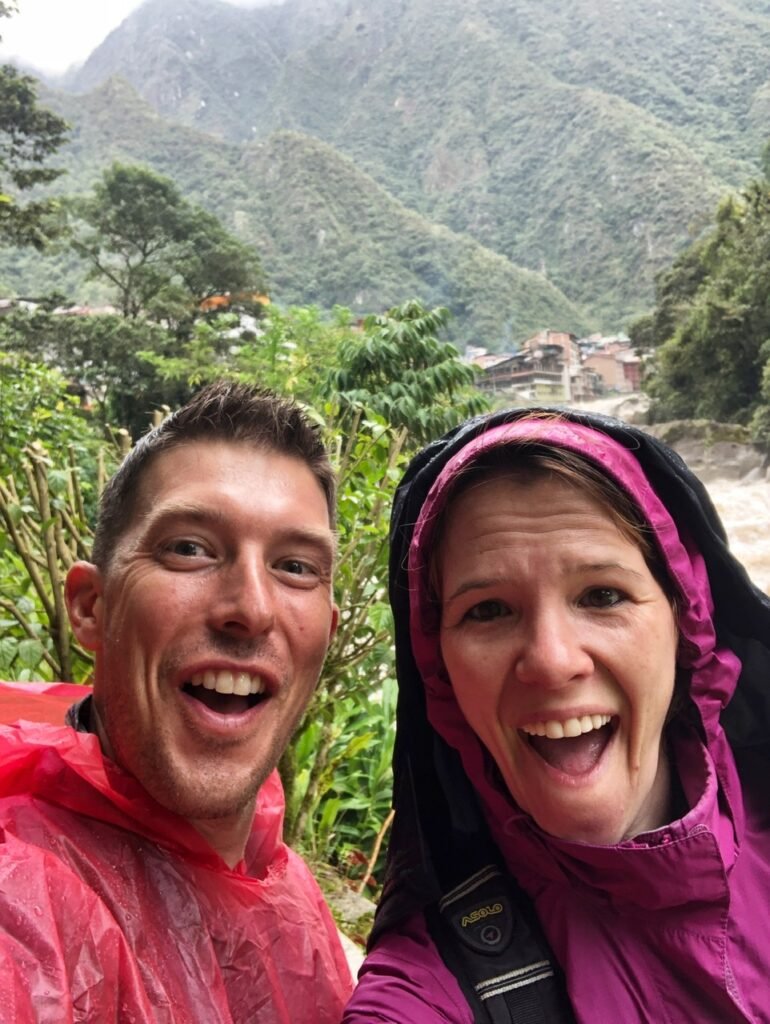
After five days, 74.2 kilometers (46 miles) and obstacle after obstacle, we made it!
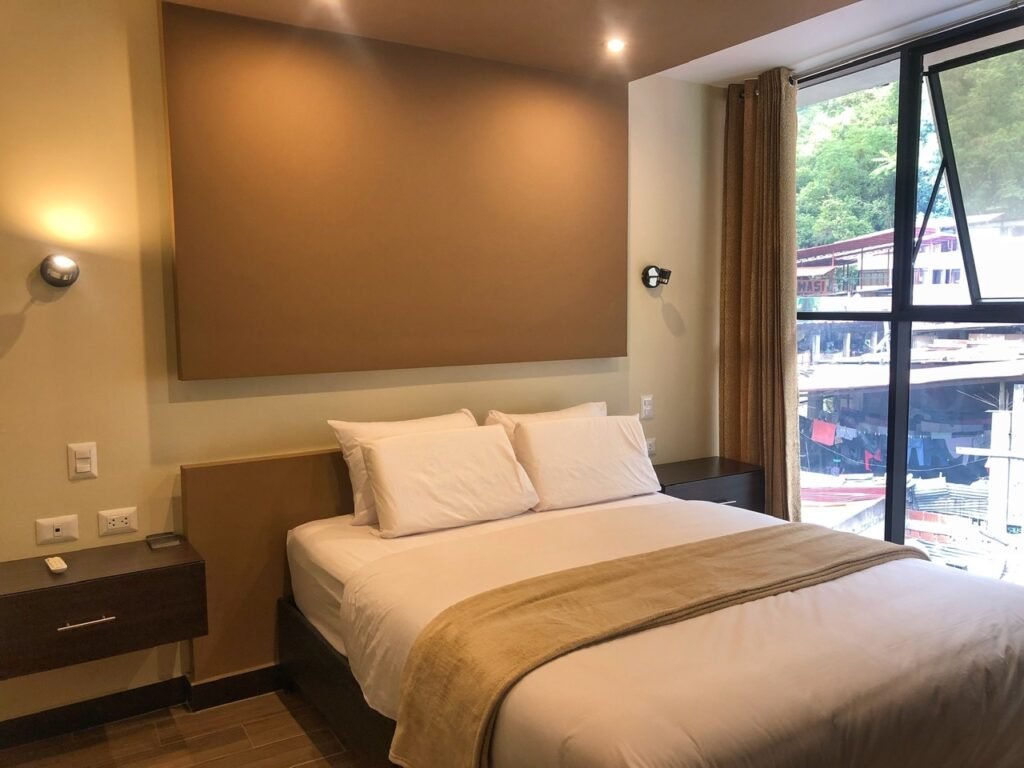
Our room at Hotel Raíces where we would stay in Agua Calientes for three nights. ($18/night, including breakfast.) One day would be devoted to rest and recovery and the other…of course…to one of the seven wonders of the new world.
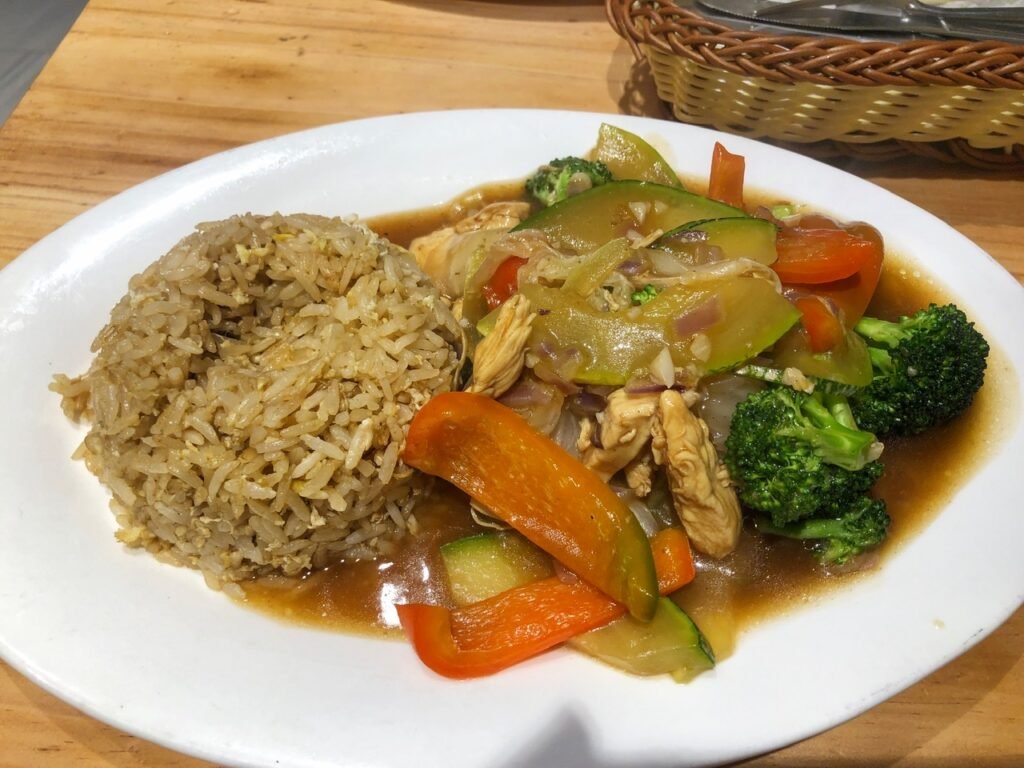
Needing a break from Peruvian standards, our first meal in Aguas Calientes was destined to be Chinese. 15 sols or $3.50.
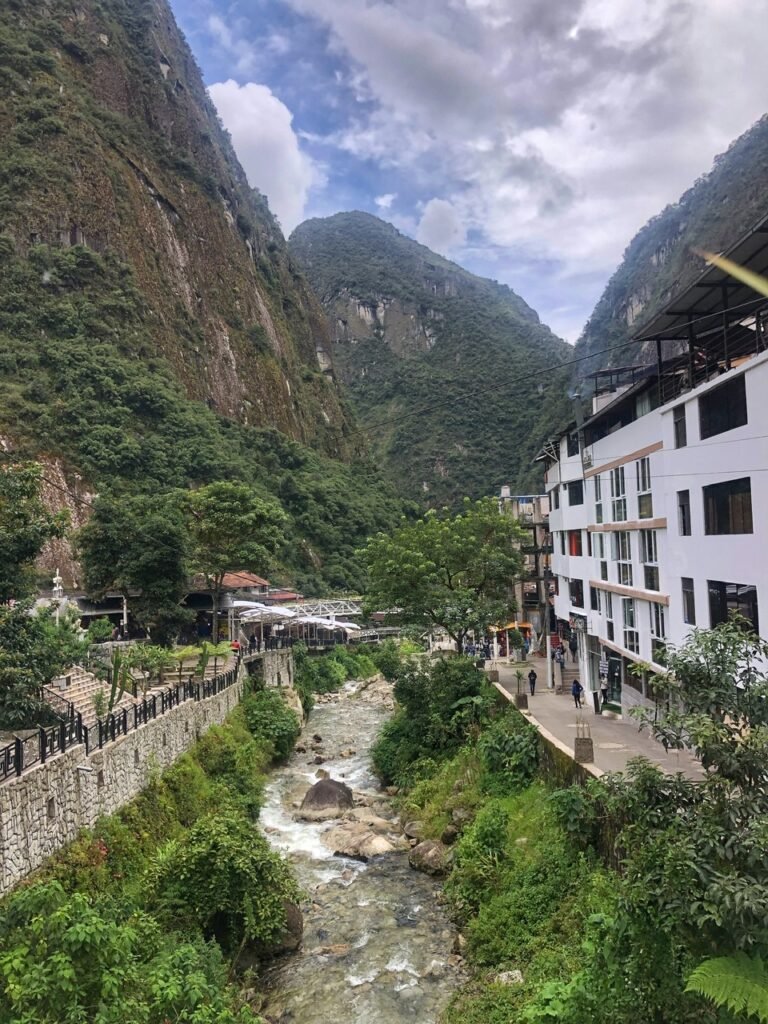
We quickly deemed the town of Aguas Calientes, also called Machu Picchu Pueblo…Machu Picchu Land. It oozes a Disney-esque version of Peru, lacks any authenticity and was clearly built only for tourism when the railroad was placed in 1931 and foreign tourists started arriving to visit Machu Picchu ruins. It’s ok, but we would choose to spend more time in Ollantaytambo as our staging ground for Machu Picchu if we did it again (we won’t!)
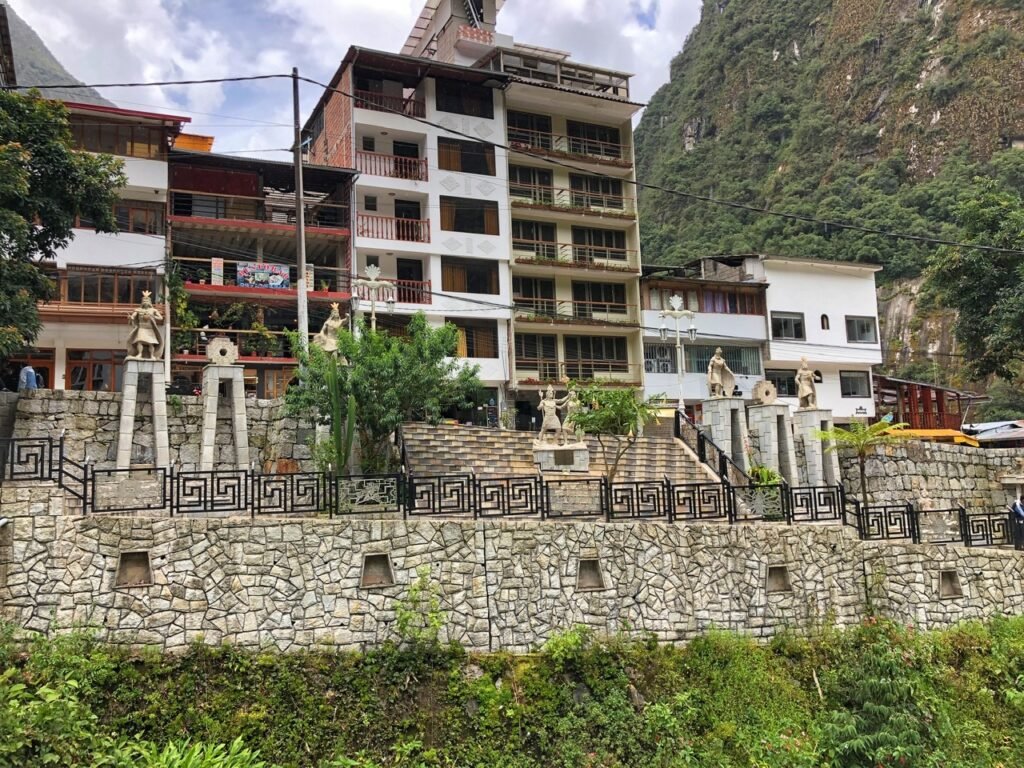
Throughout the village you’ll find things like cheesy Incan statues which are way too tall to be Peruvian, with mega abs.
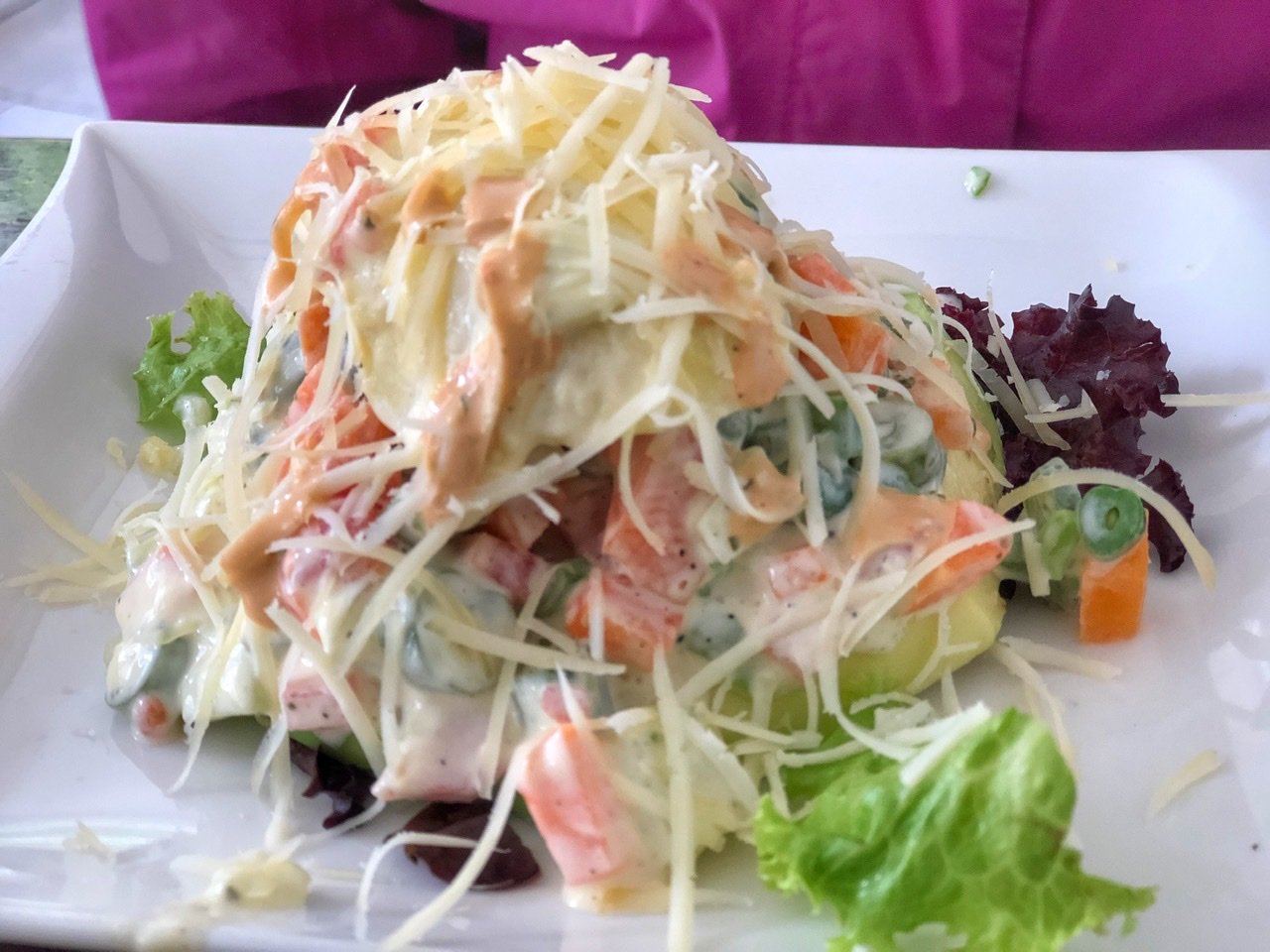
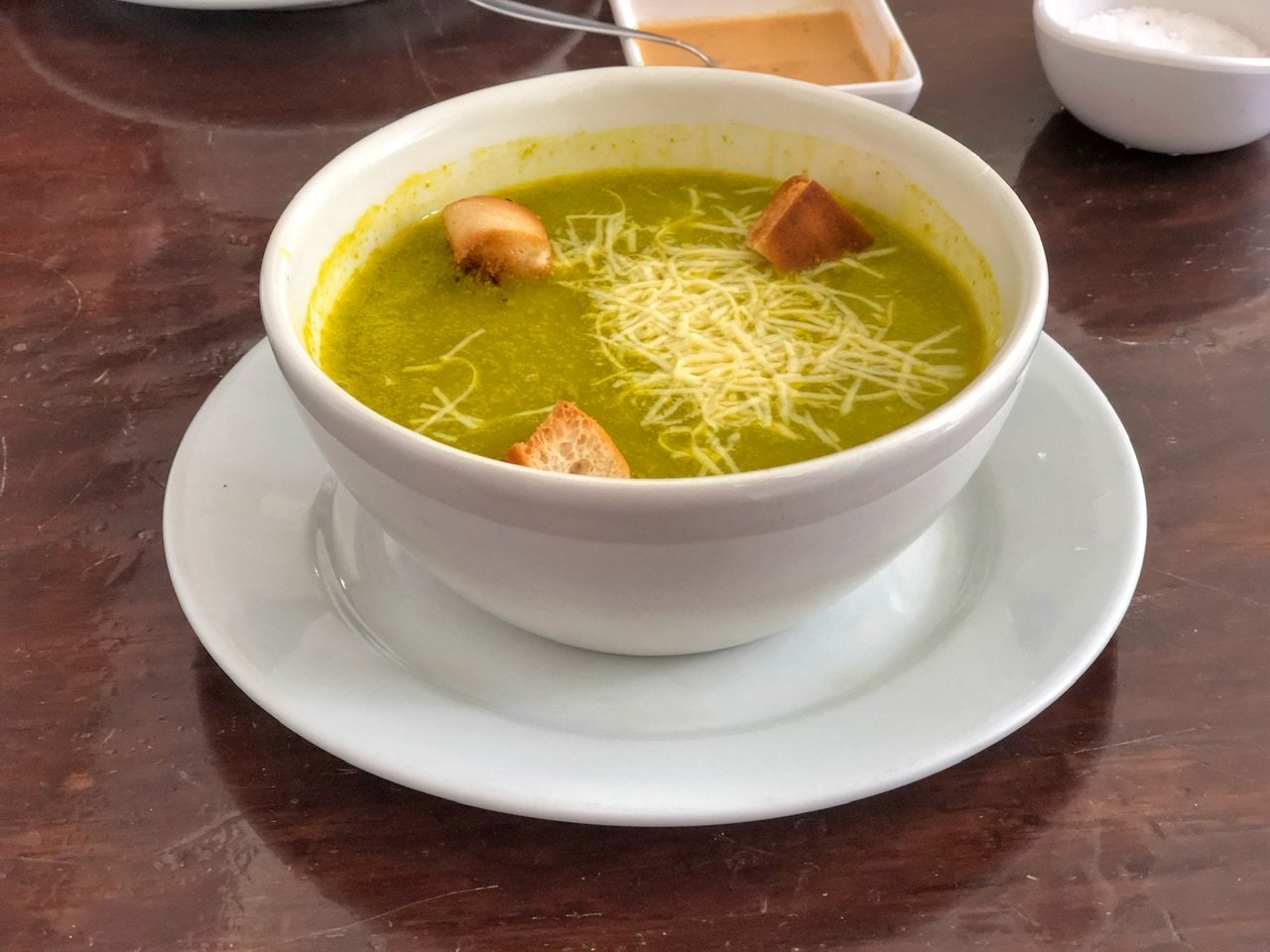

And even though the prices were very inflated, (like a coffee for 12 soles or over $3), it was very possible to find good values in Menu Turísticos. This one included three courses plus a drink for 20 soles or around $5. The first course was Palta Rellena, or stuffed avocado, one of our new favorites. It was stuffed with corn, green beans, peppers cheese and a lime/mayonnaise dressing. Very light and refreshing!
Second course was sopa de calabeza or pumpkin soup.
The main course was Trucha a la Plancha…grilled trout, and of course rice and French fries. Even though this is the land of the potato, not sure the Peruanos know how to cook their potatoes any of the other hundreds of ways ?

Mandy’s mangled foot. We wrapped it up using internet advice and our limited First Aid supply. She would definitely have some healing to do and her current shoes are going in the bin.

